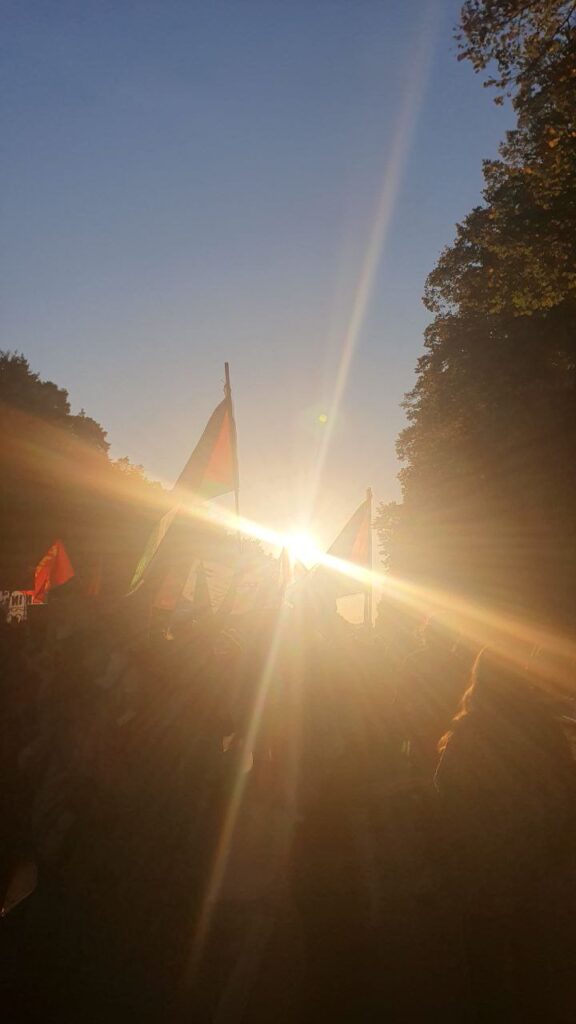
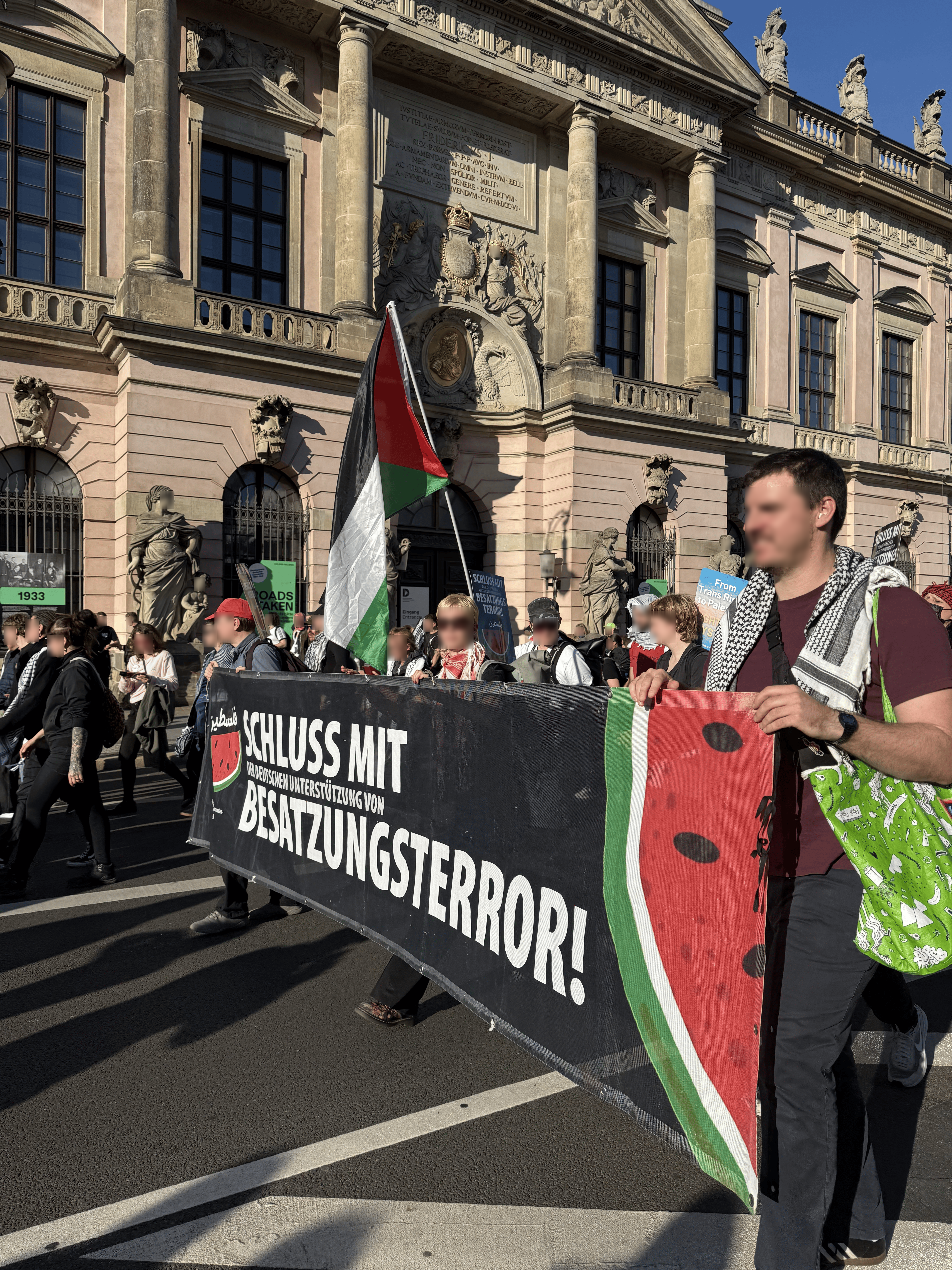
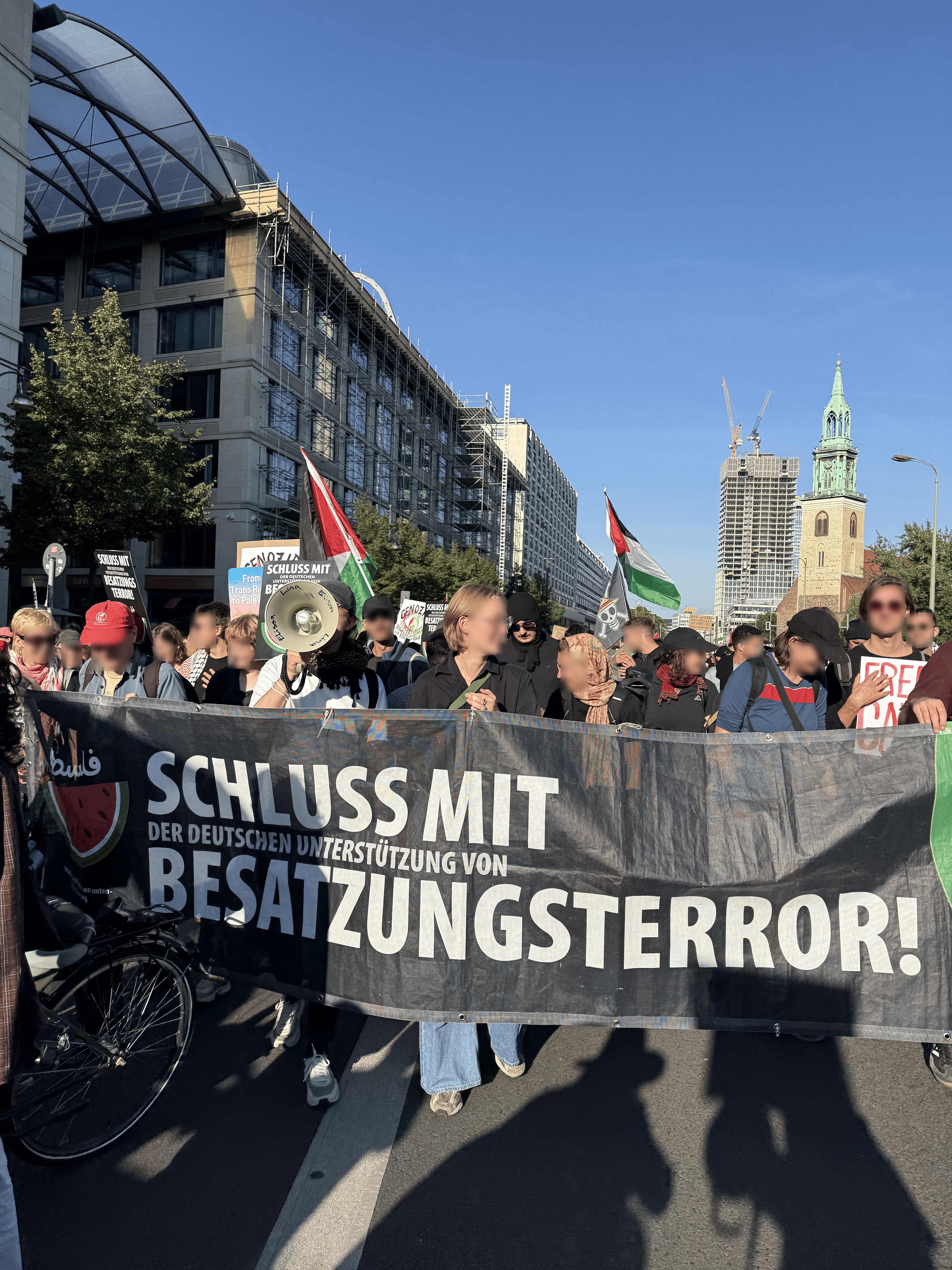
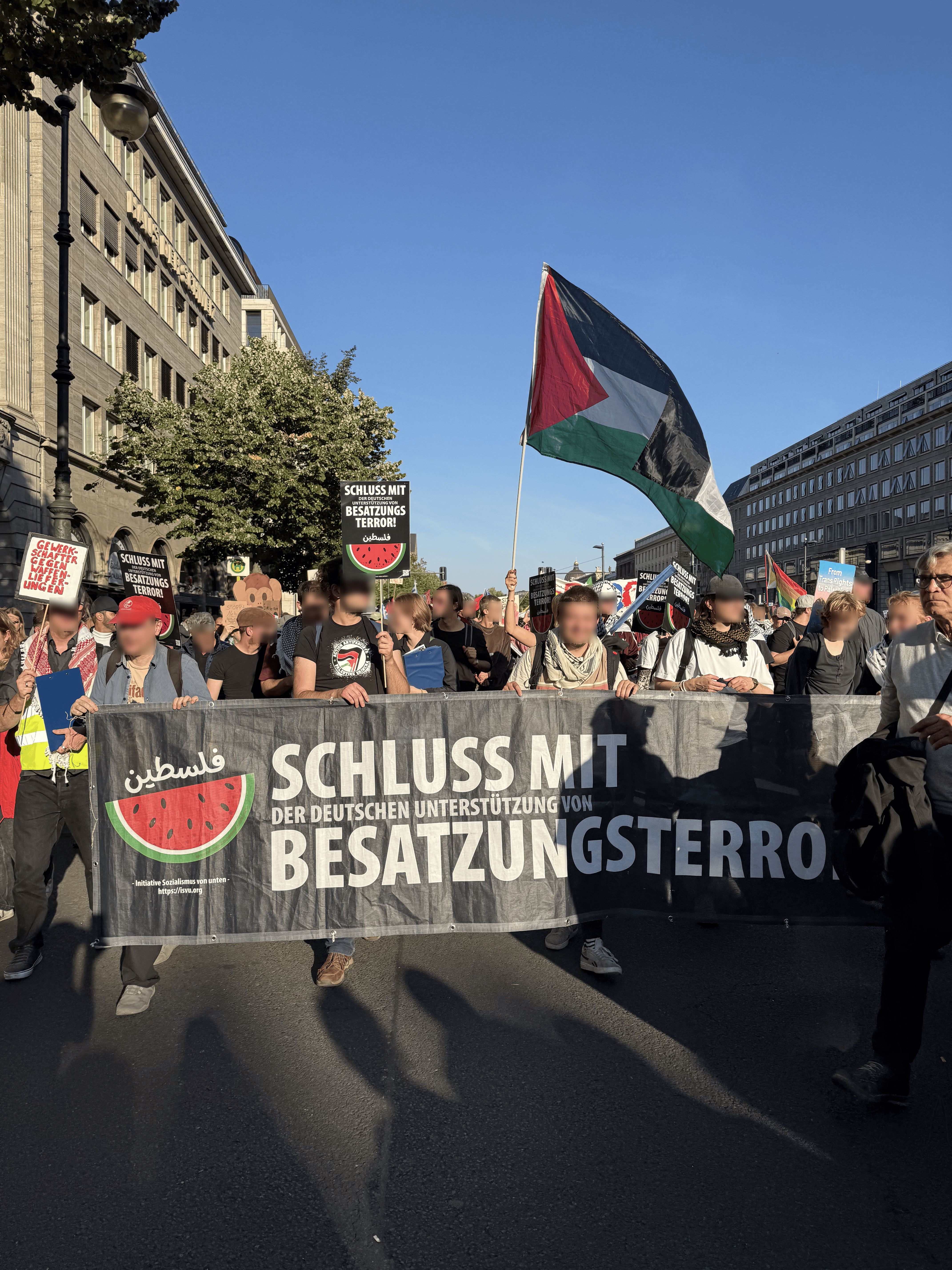
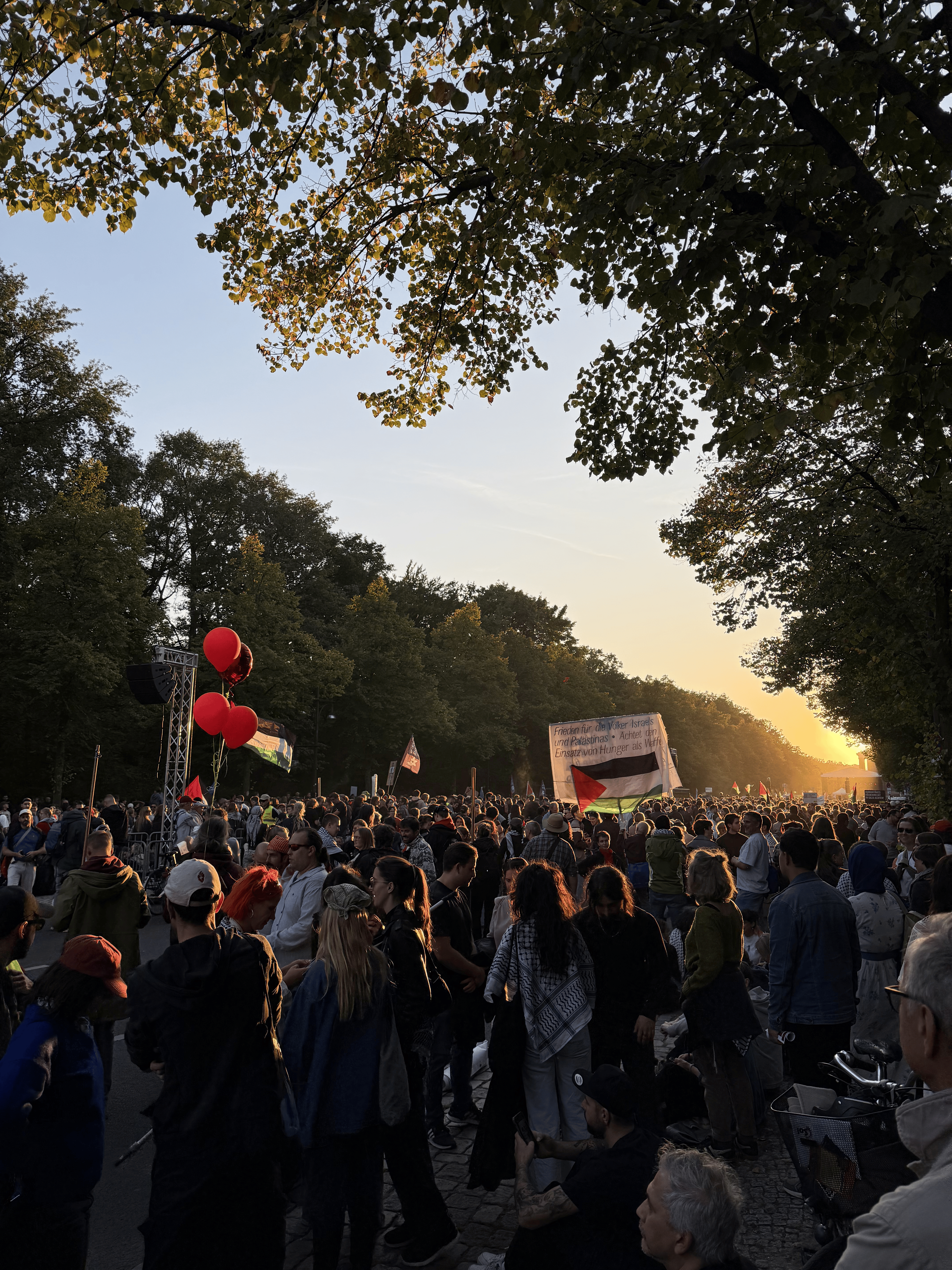
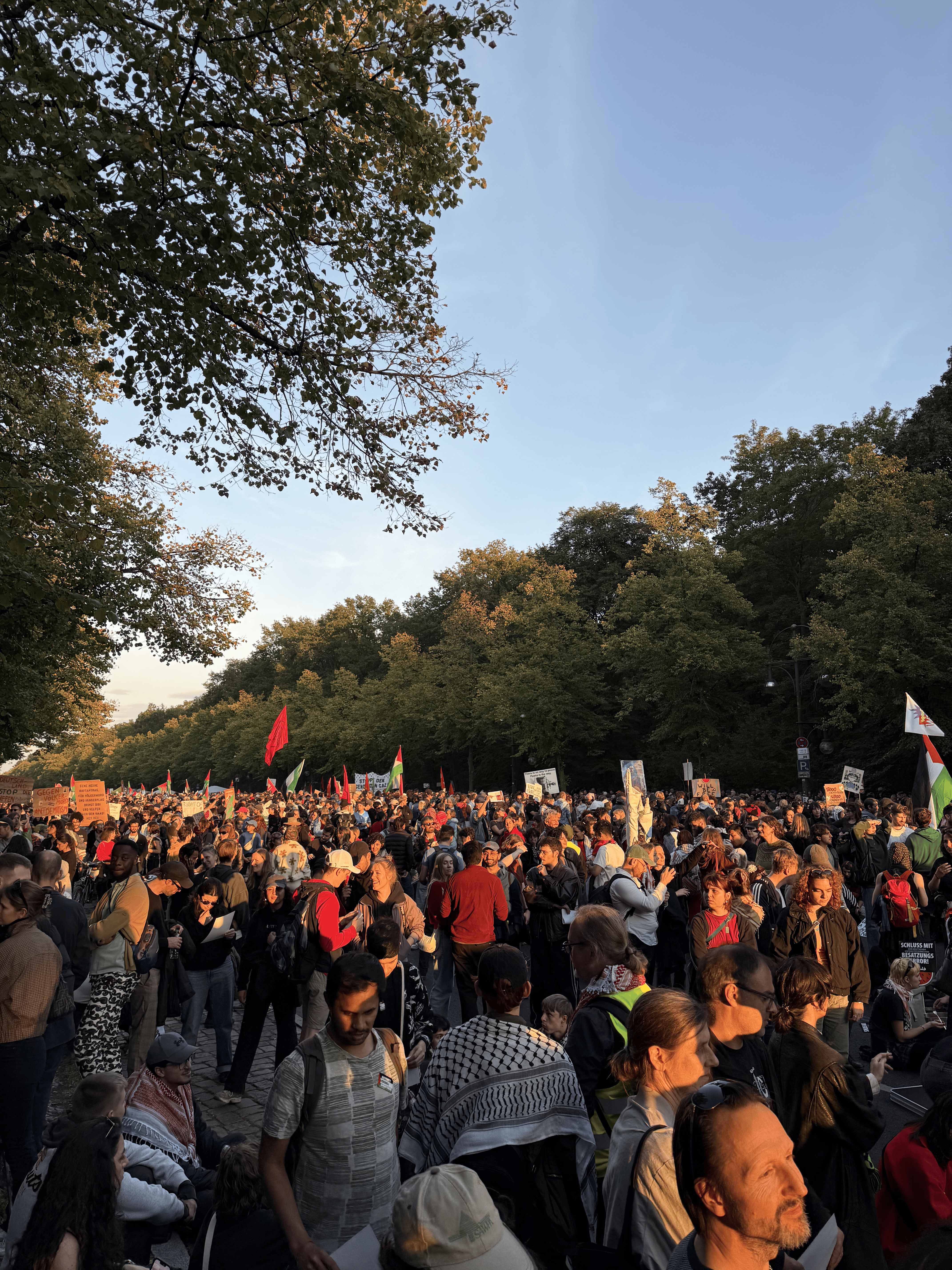
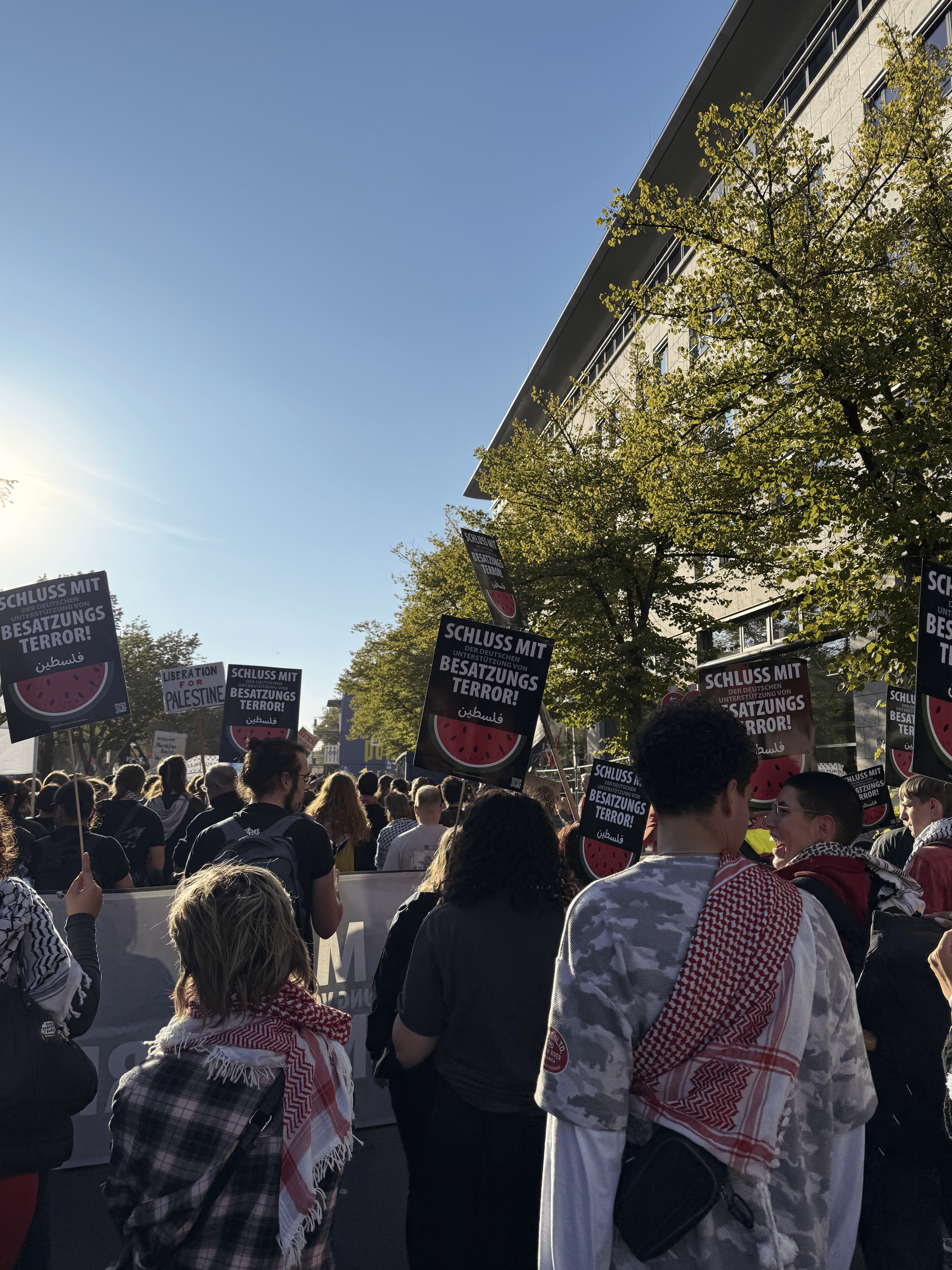
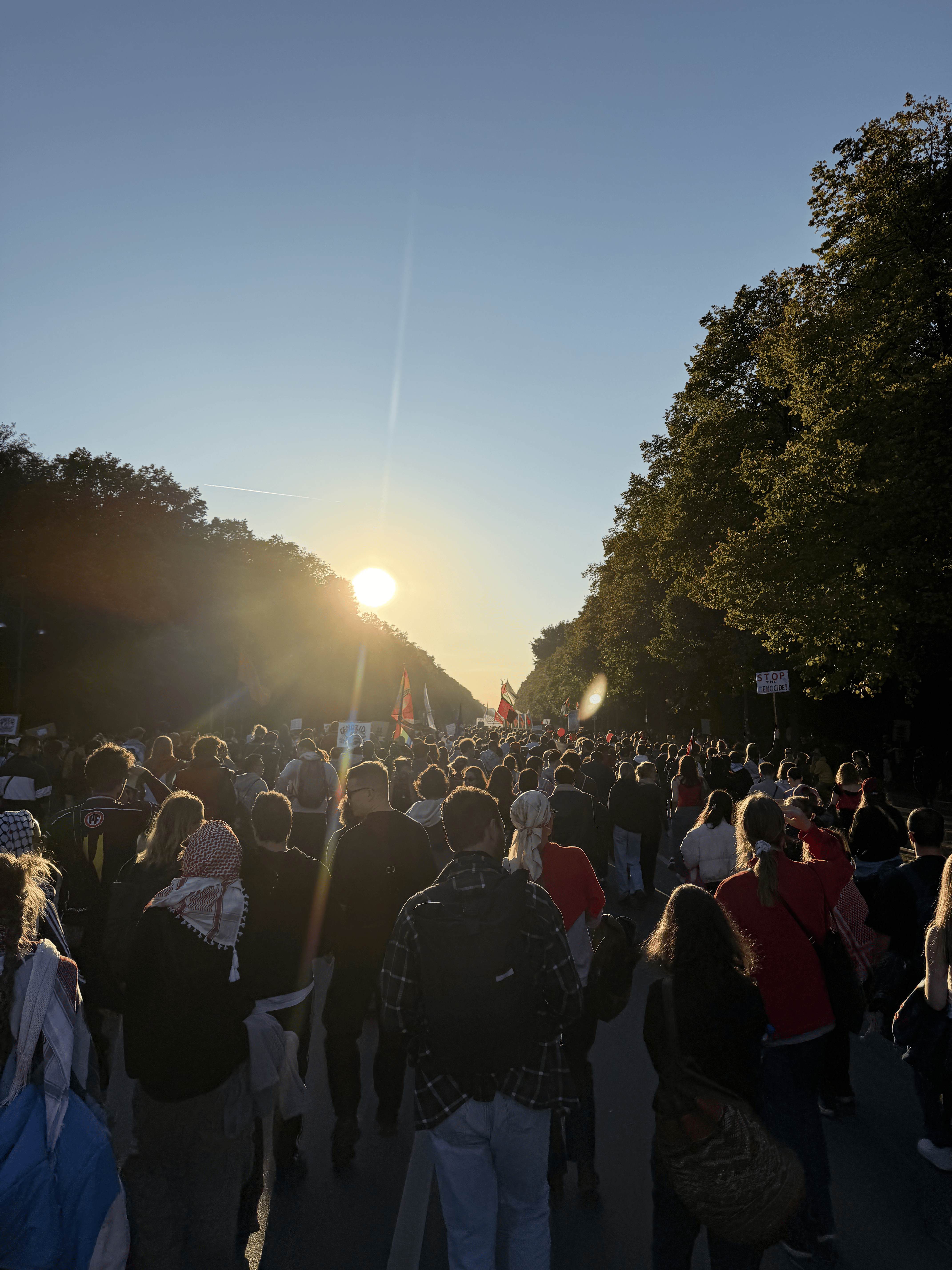
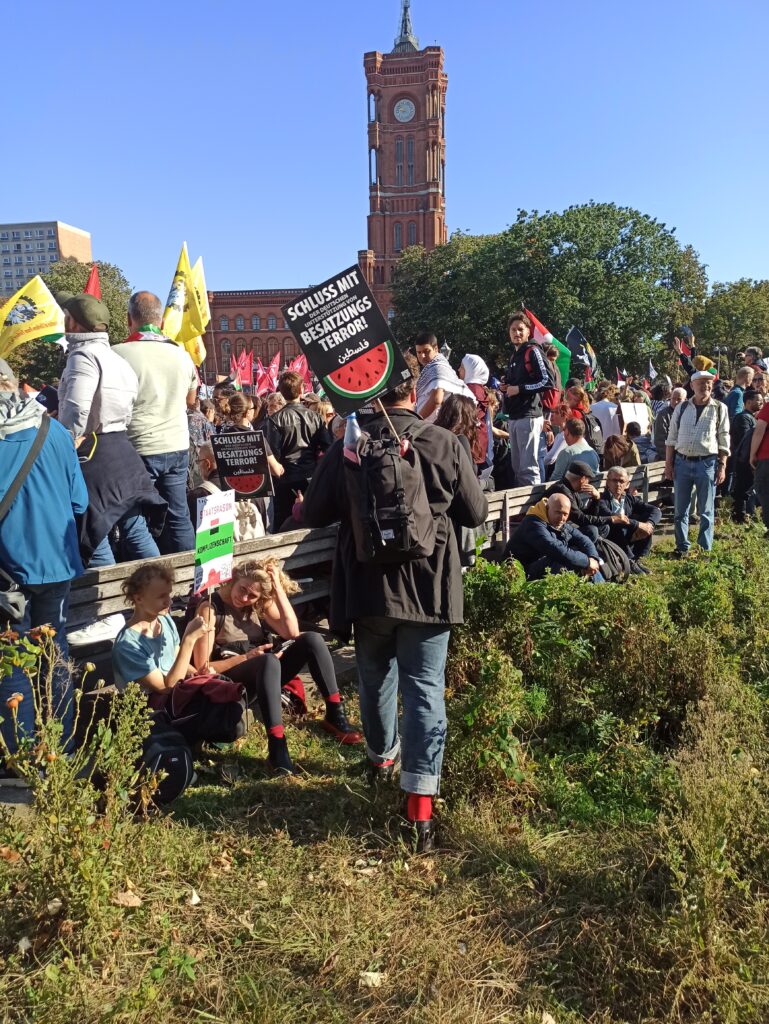
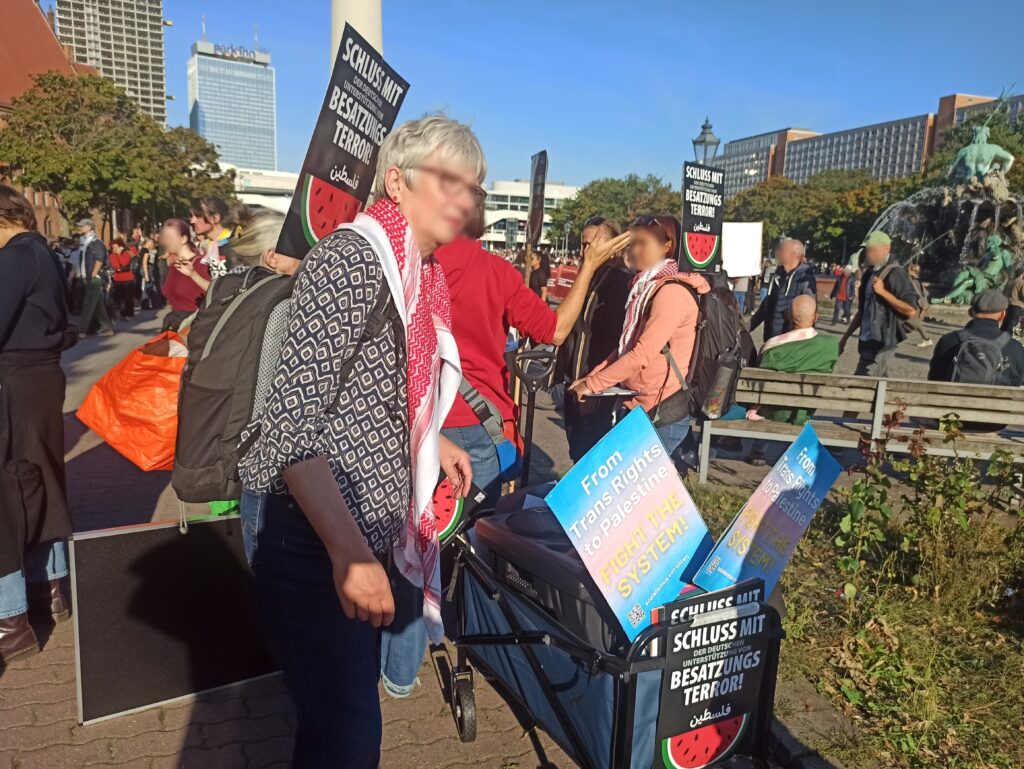
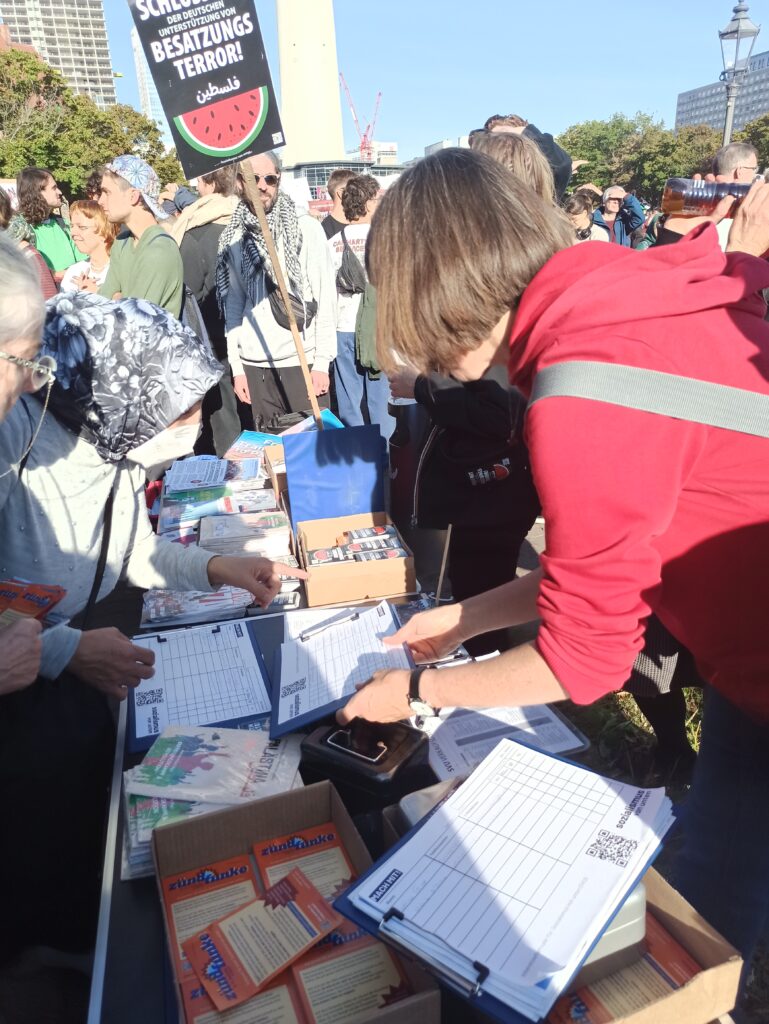
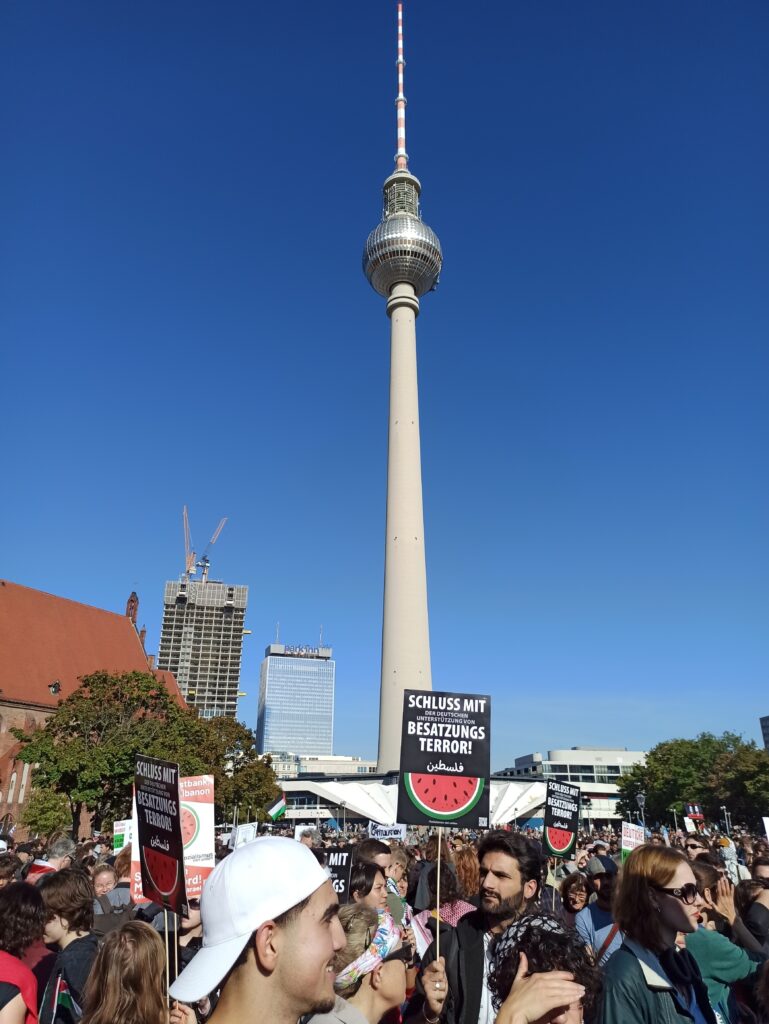
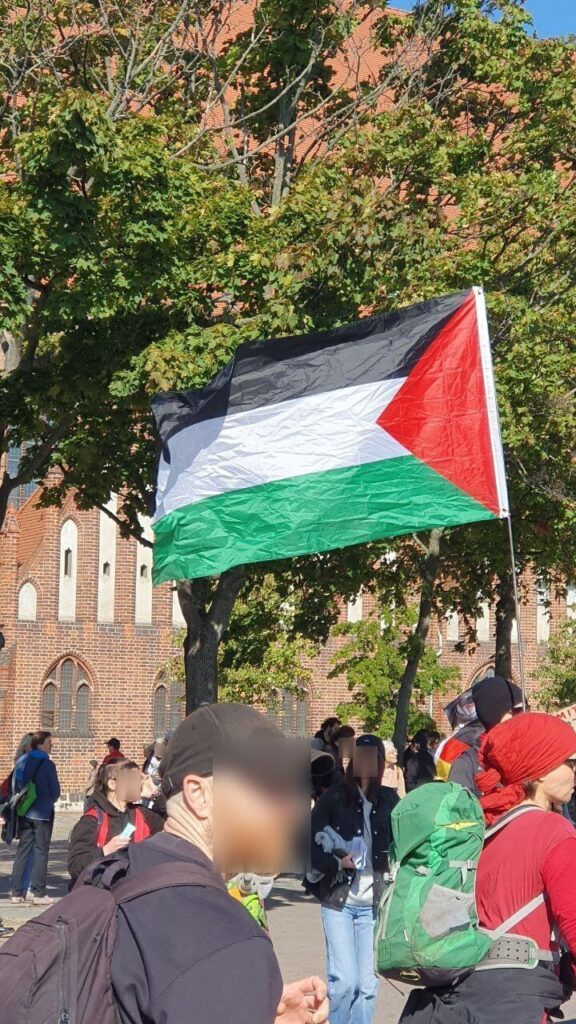
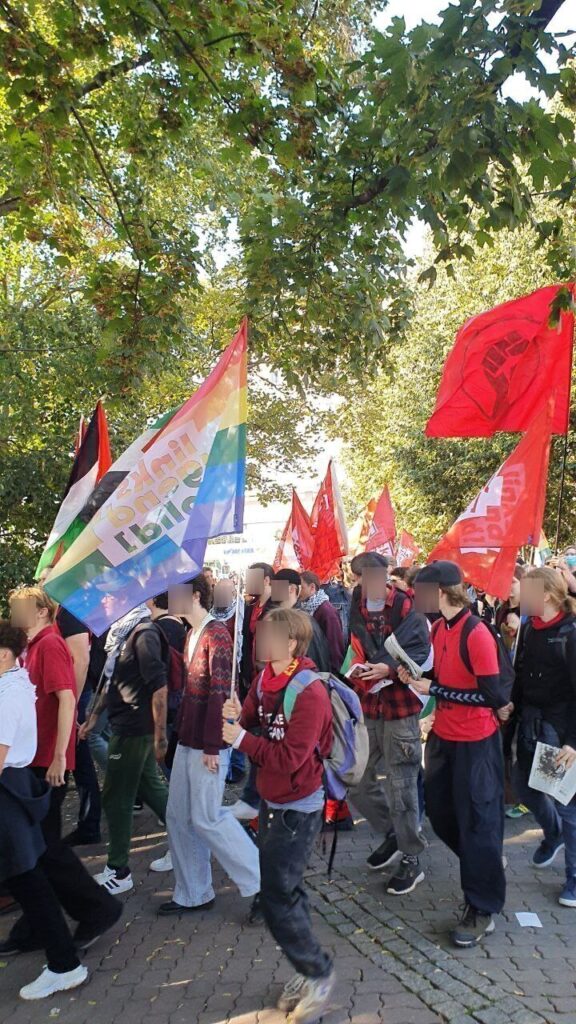
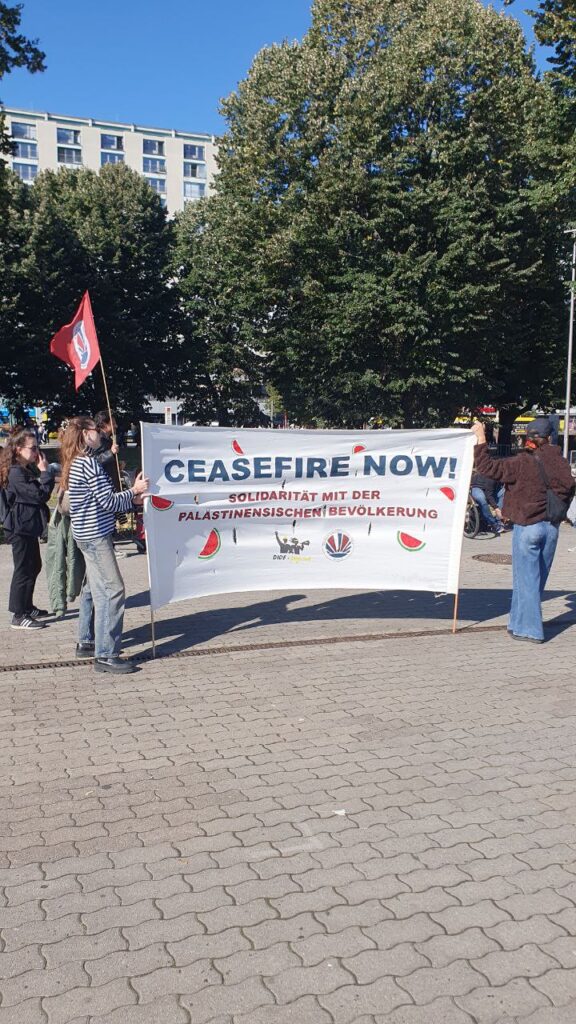
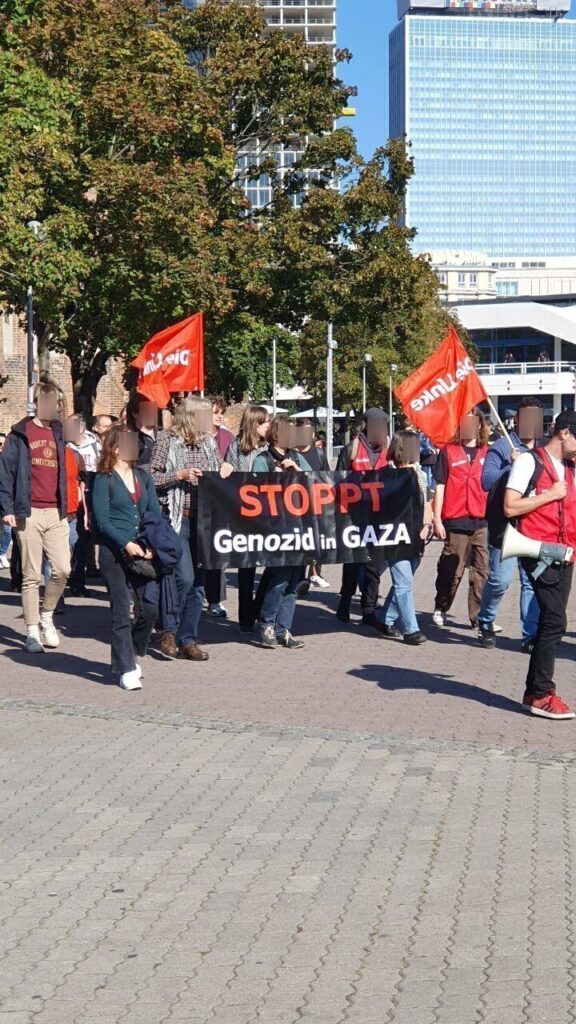
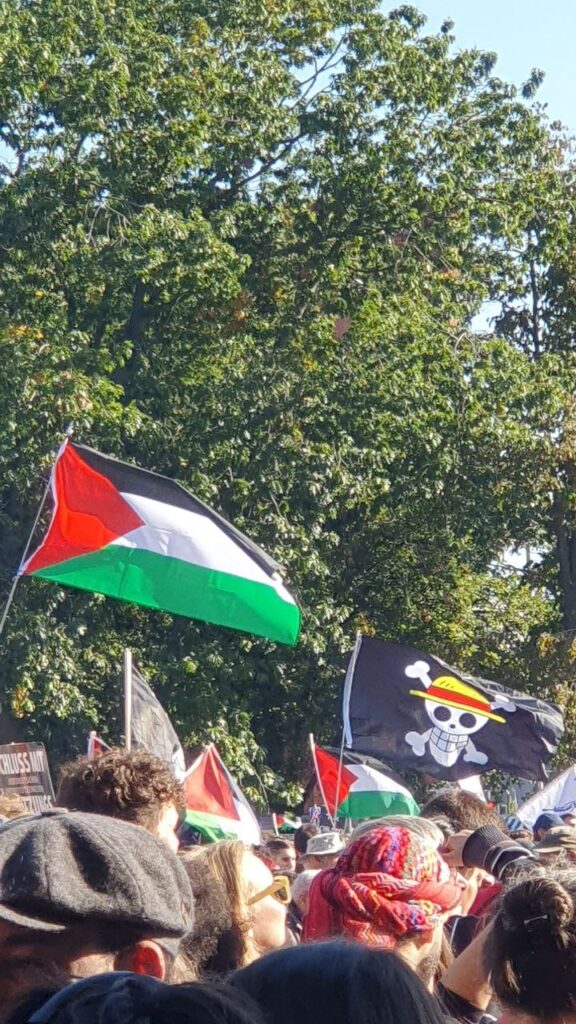
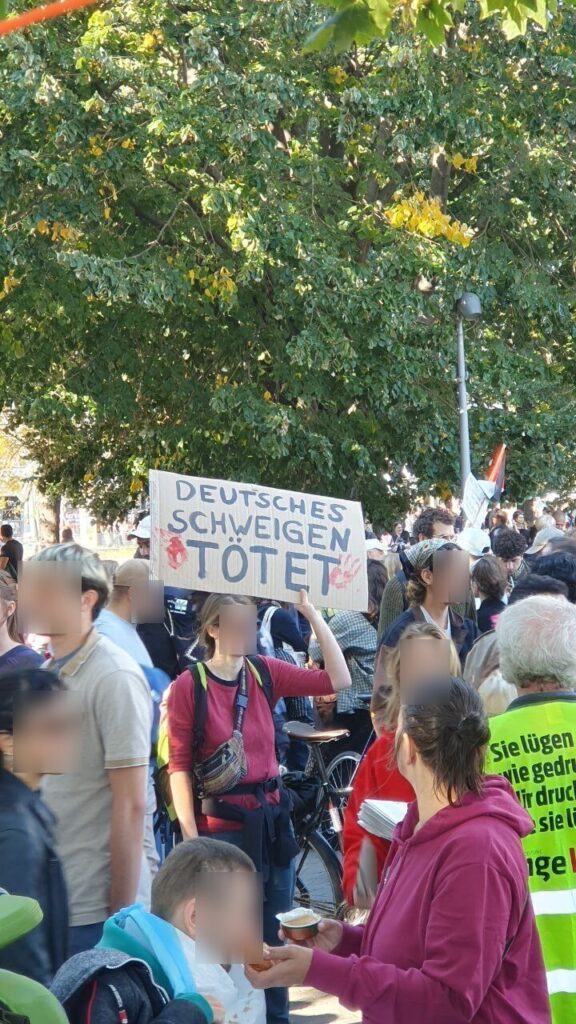
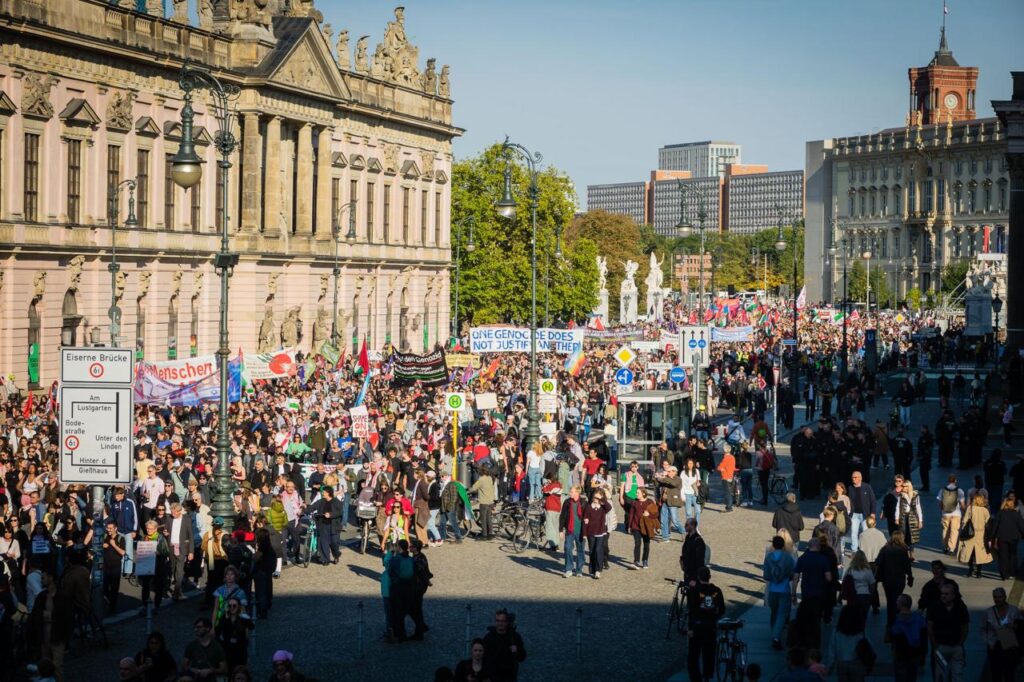
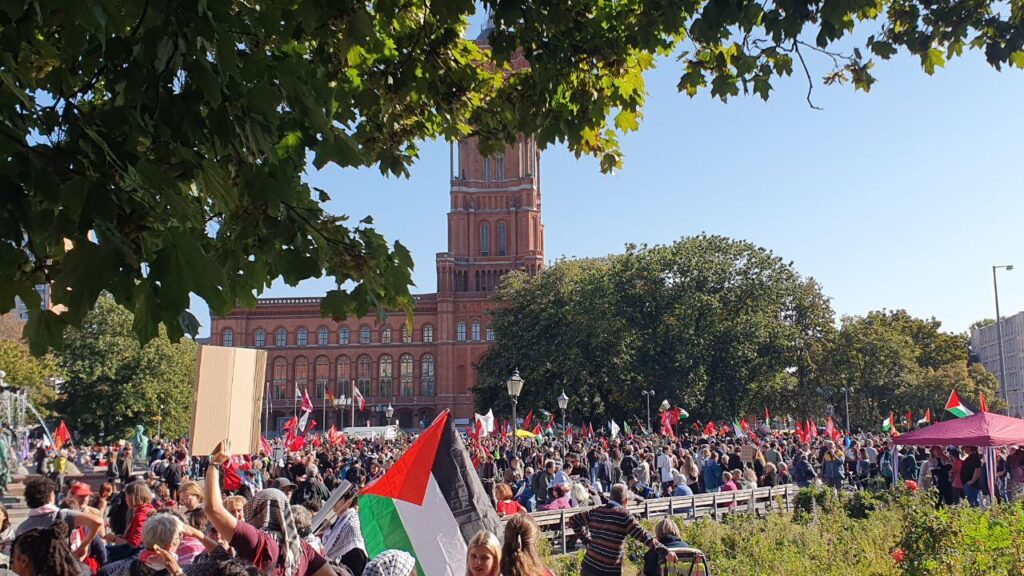
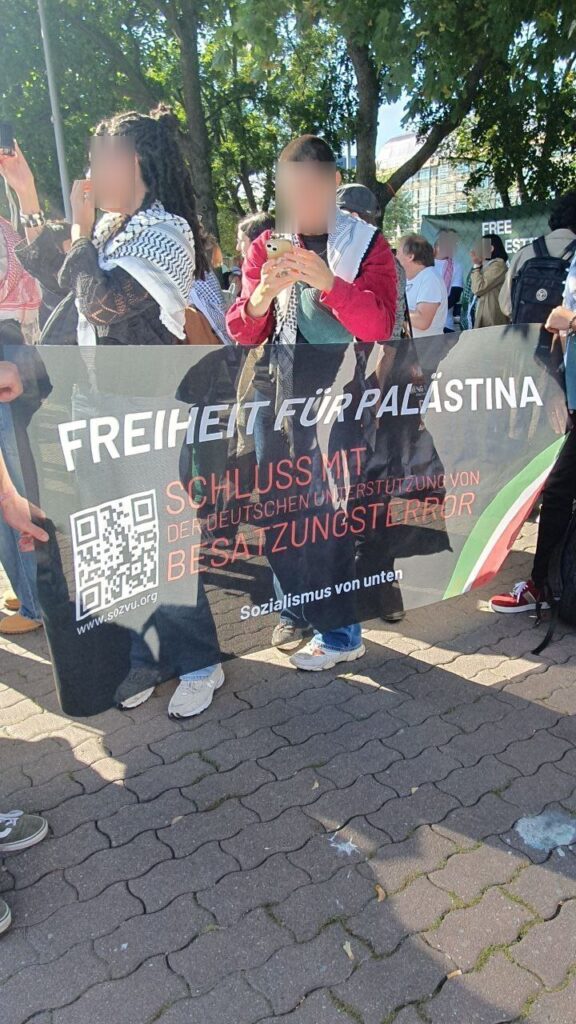
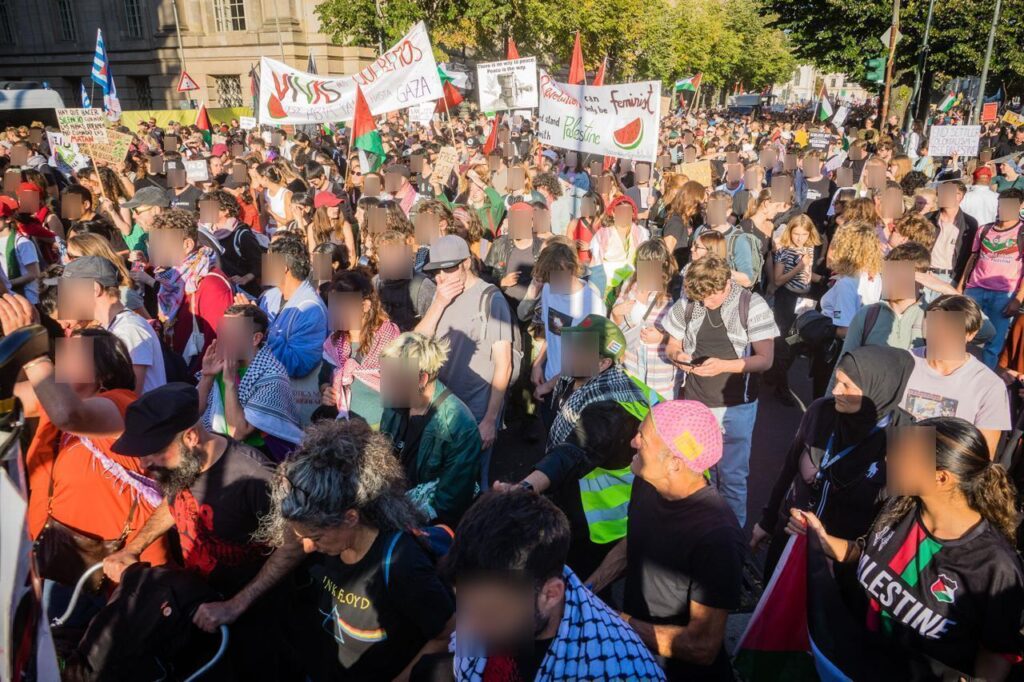
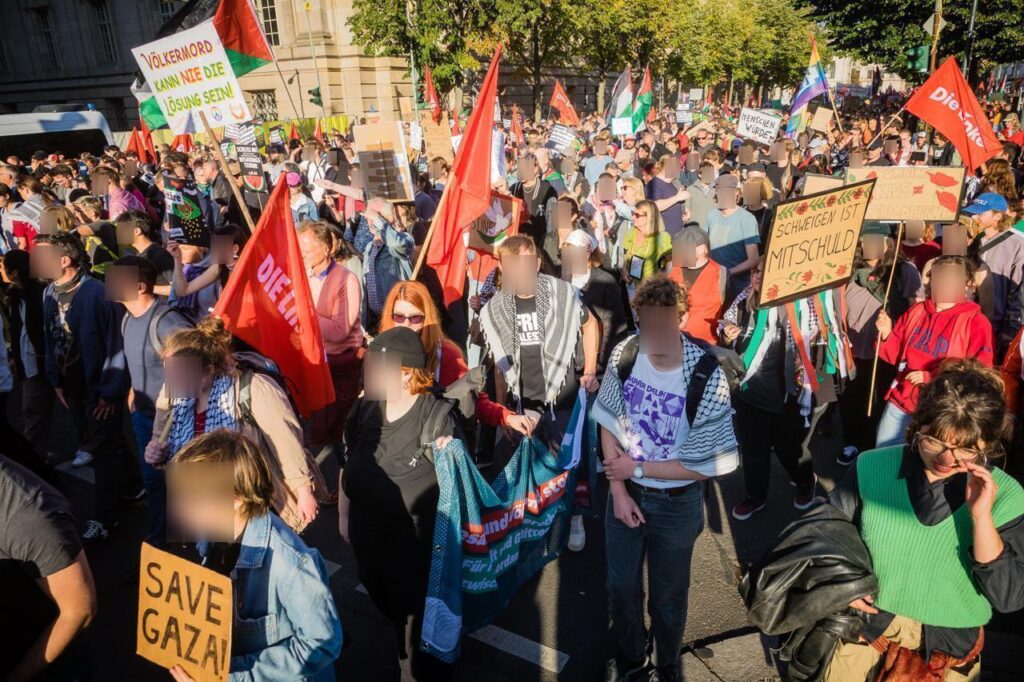
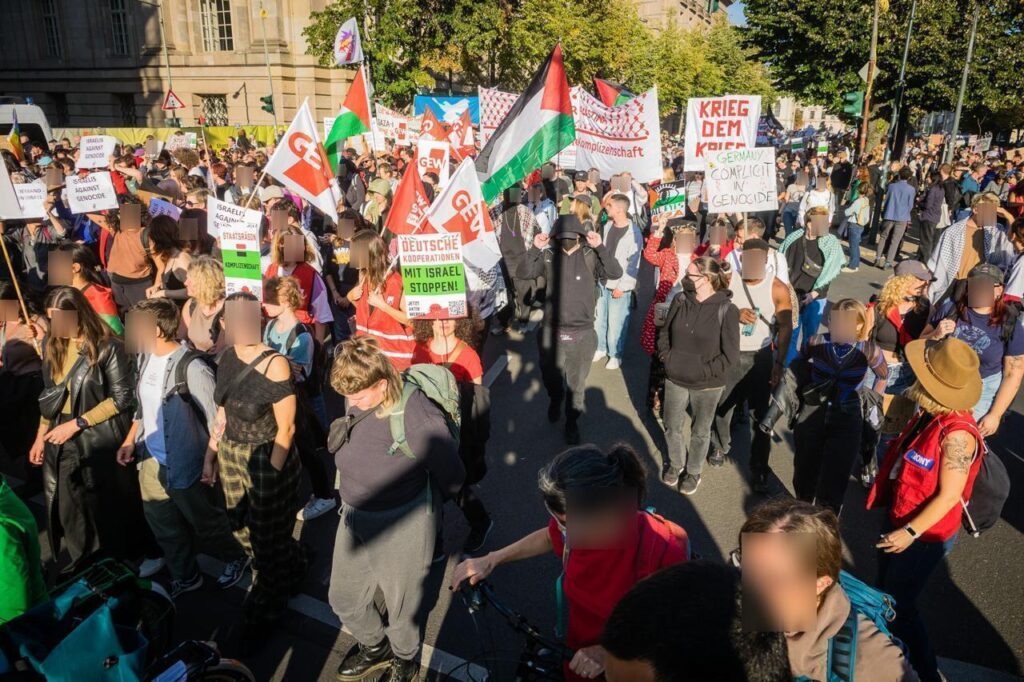
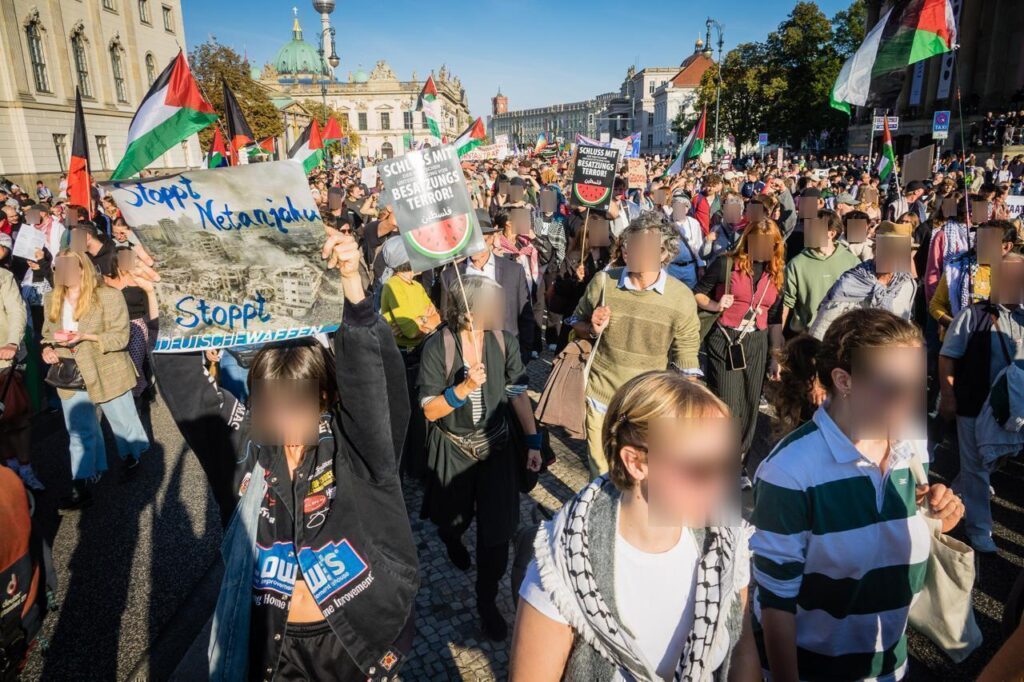
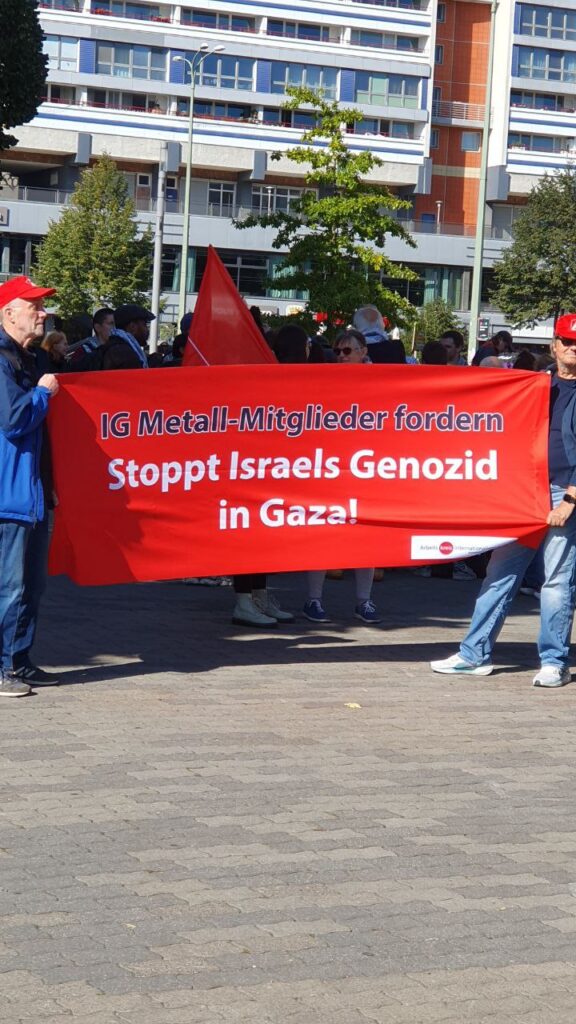
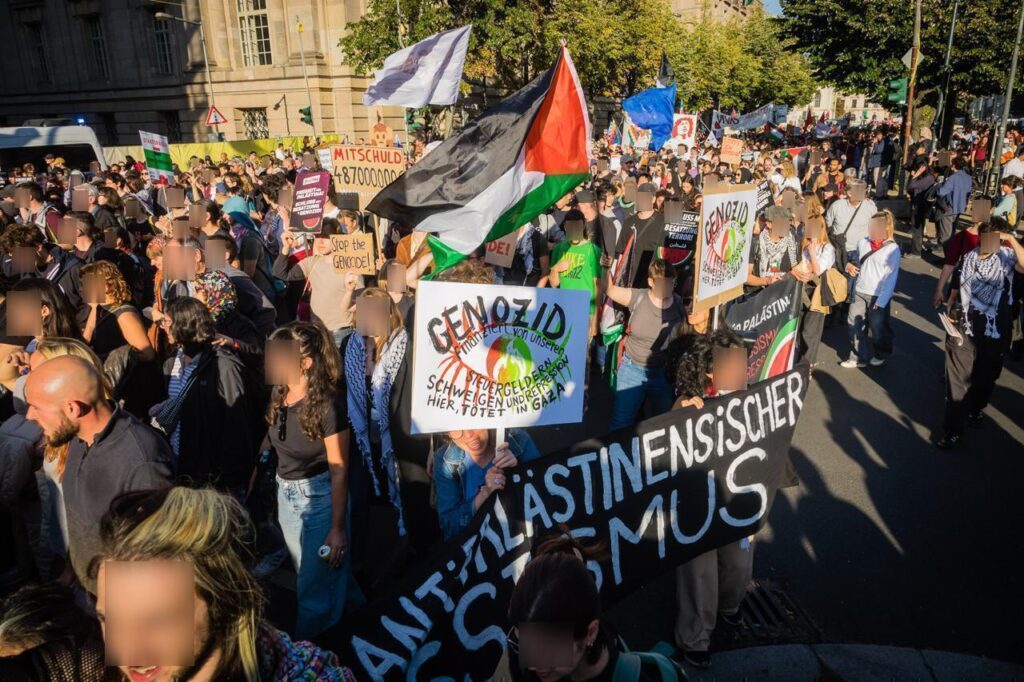
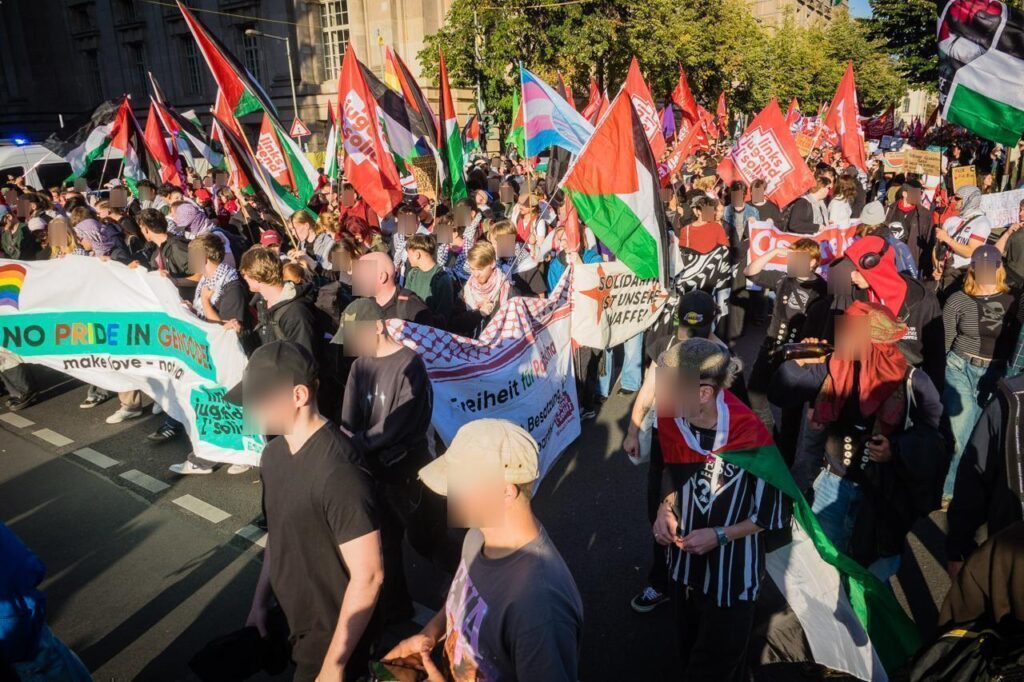
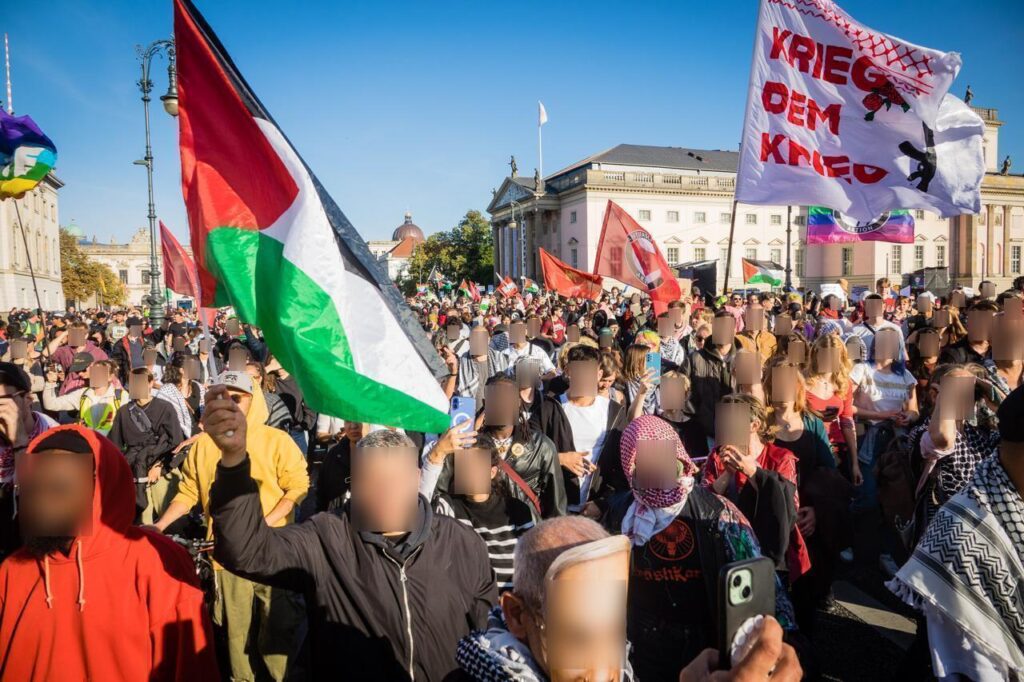
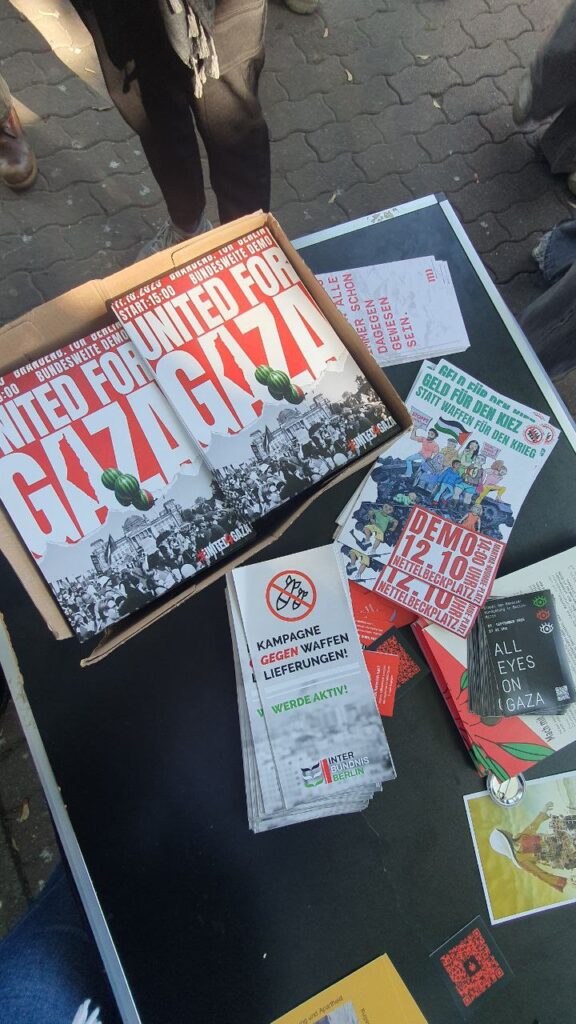
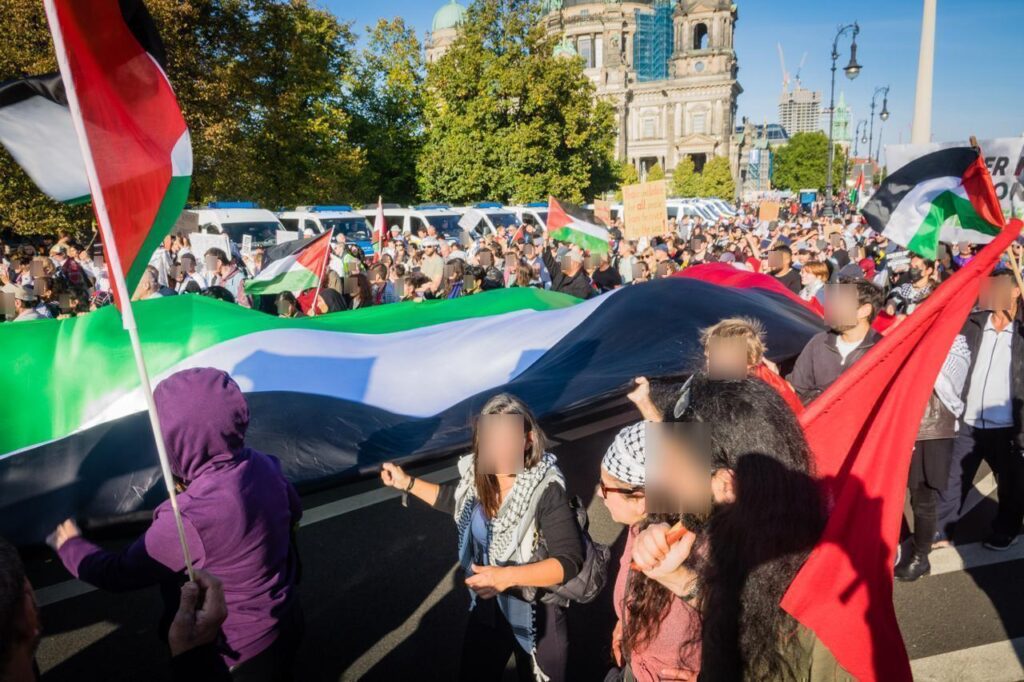
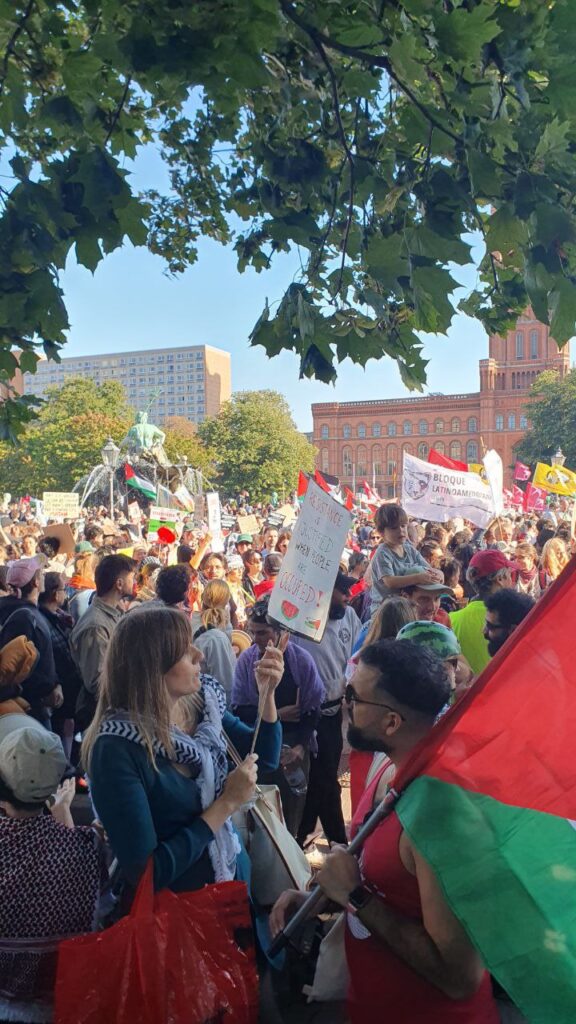
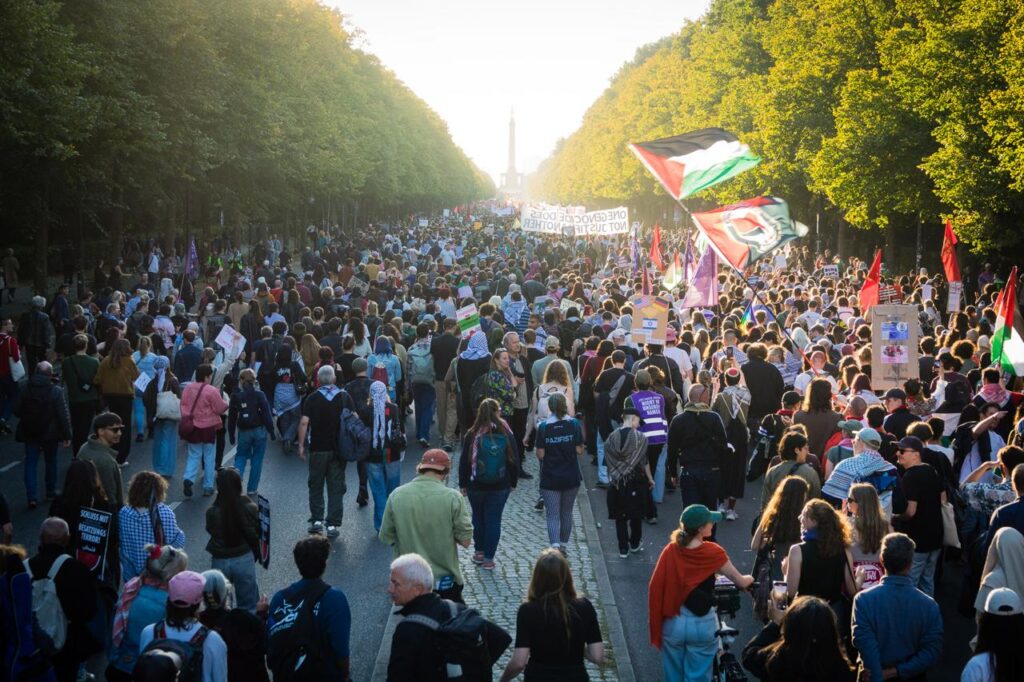
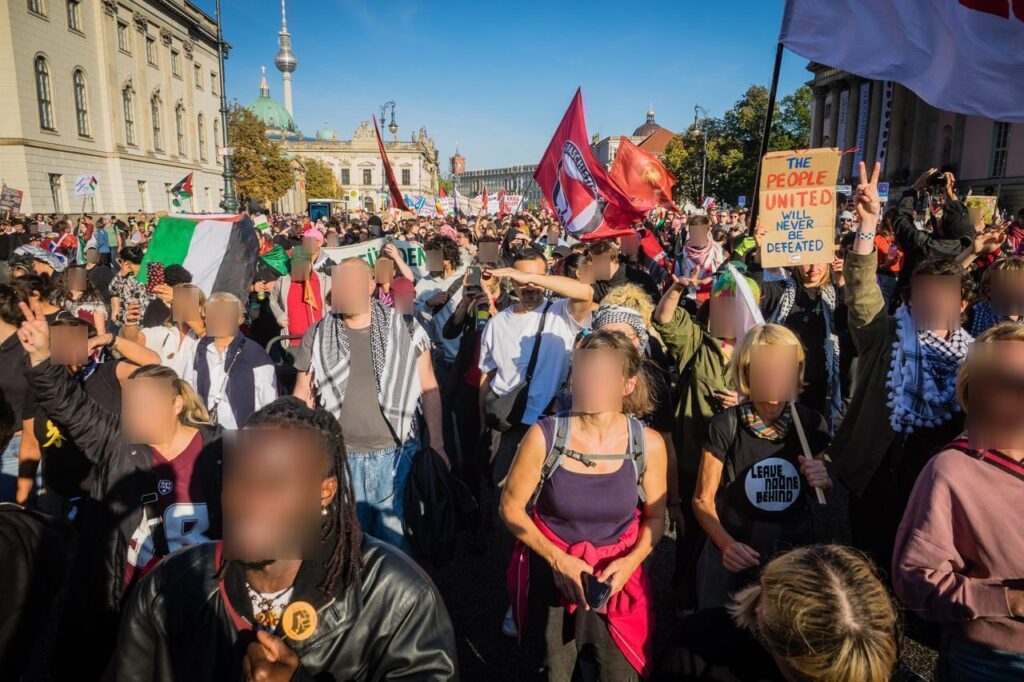
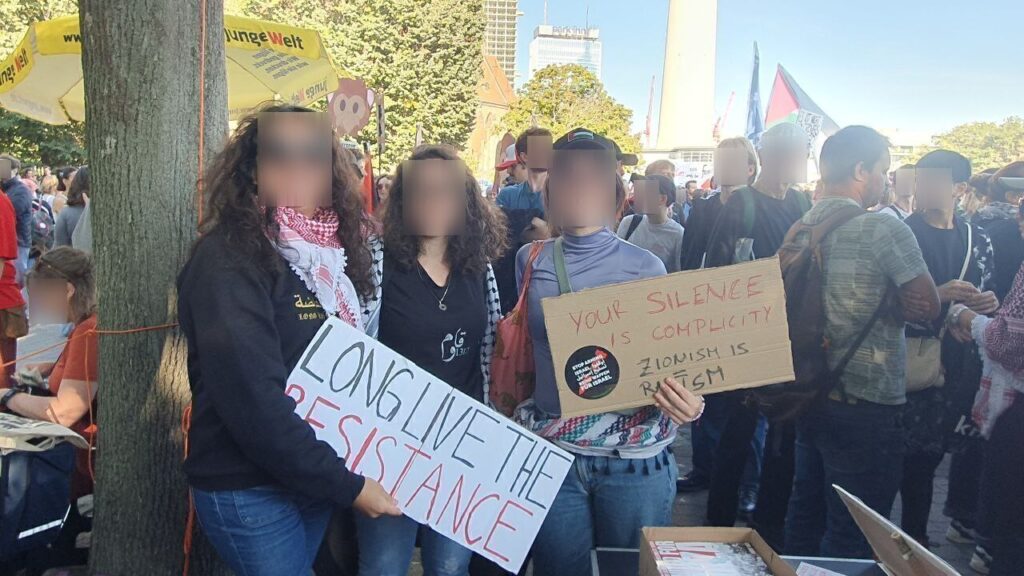
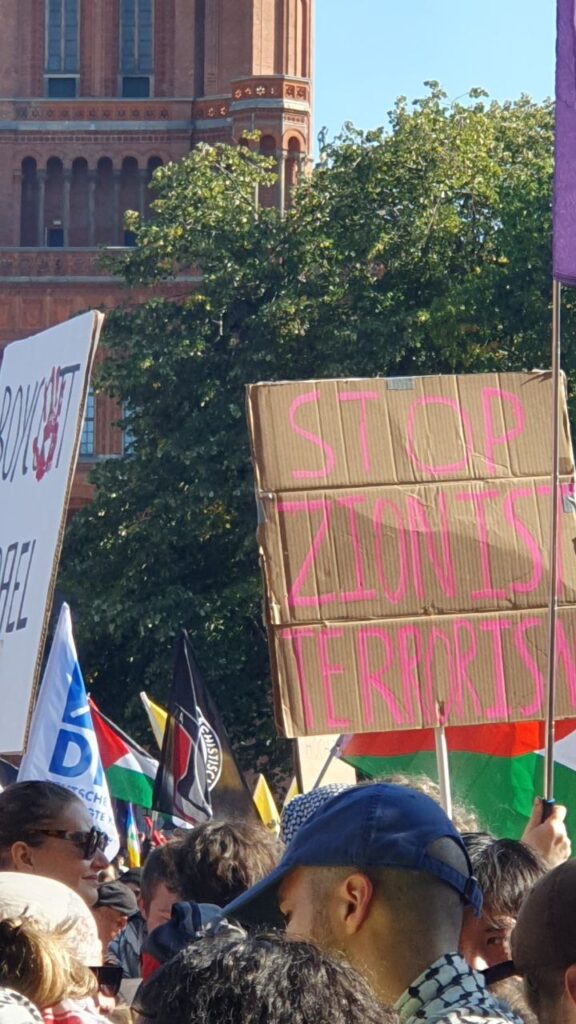
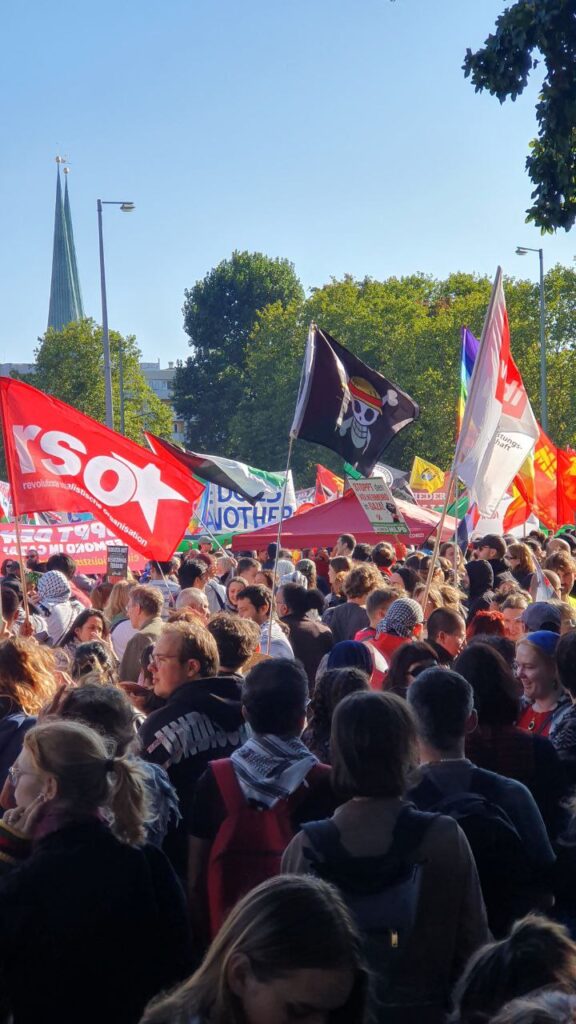
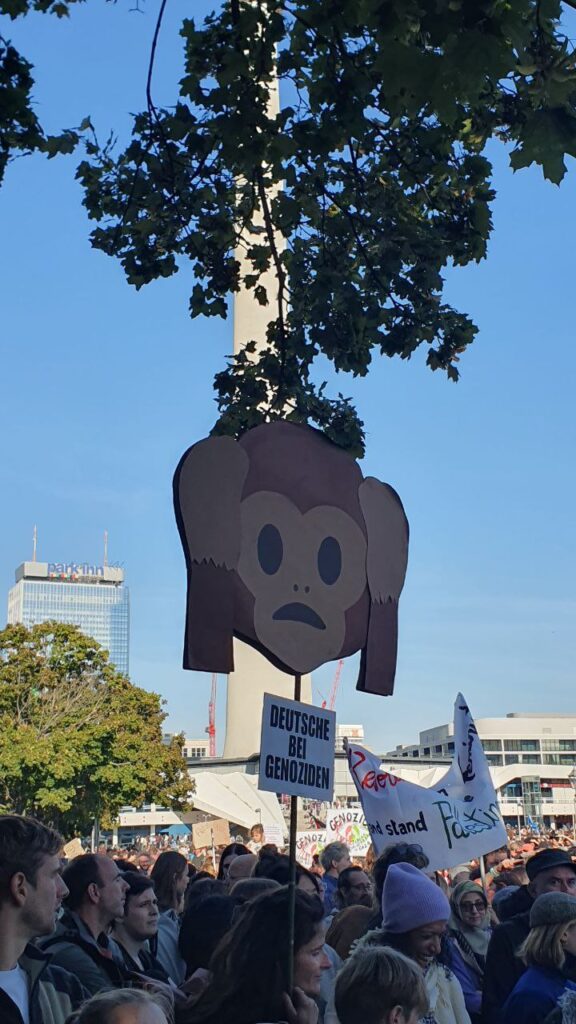
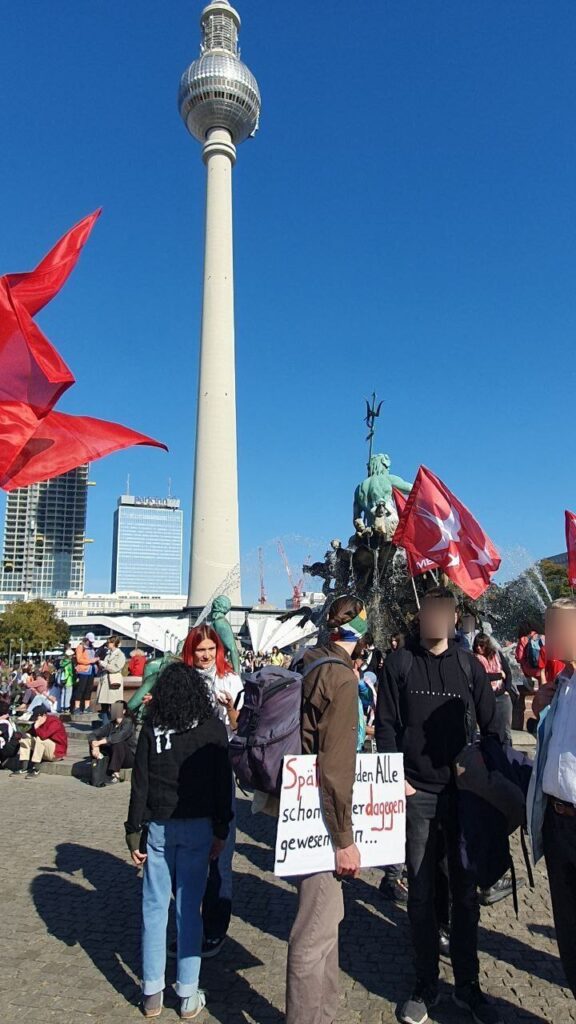
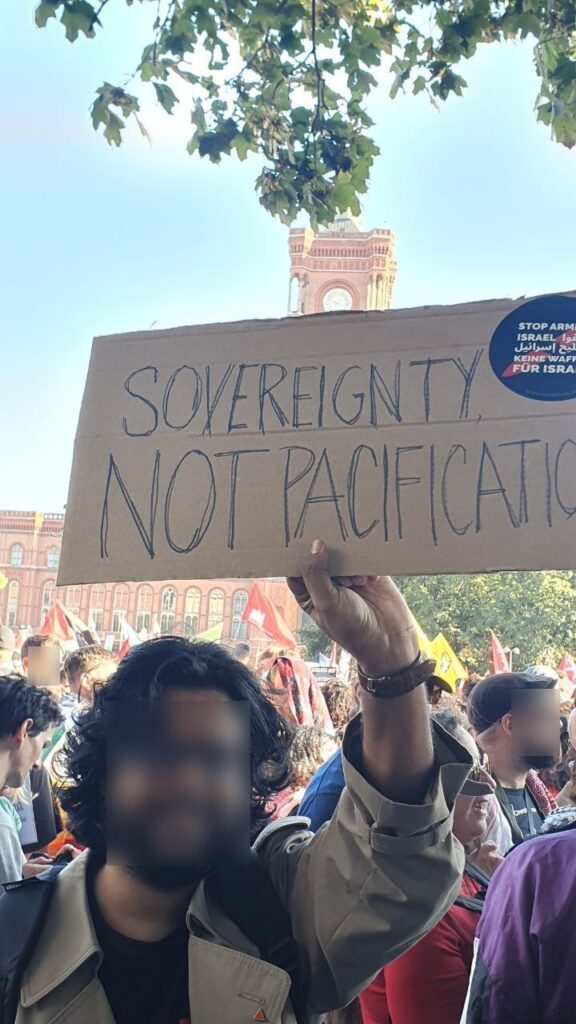
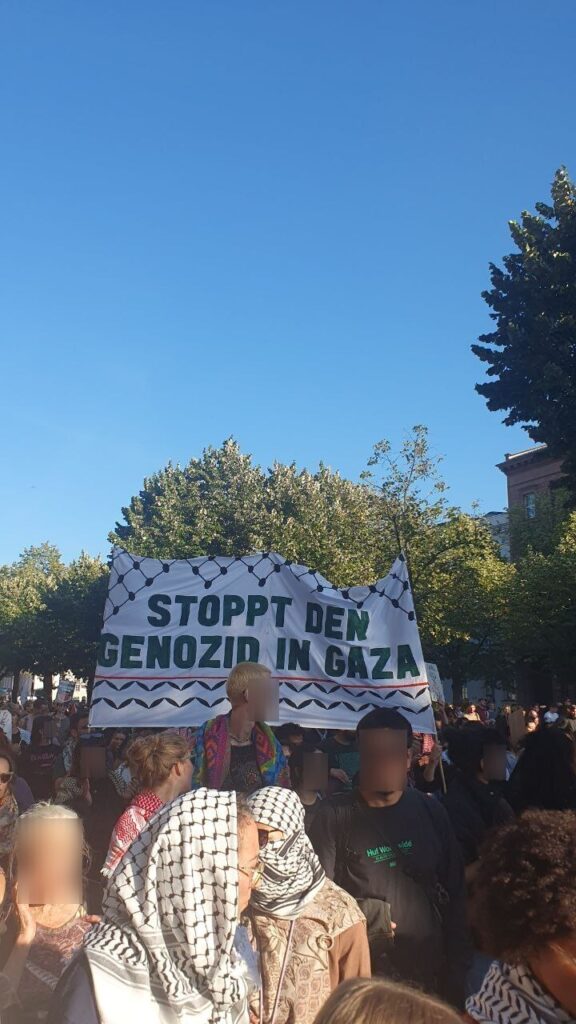
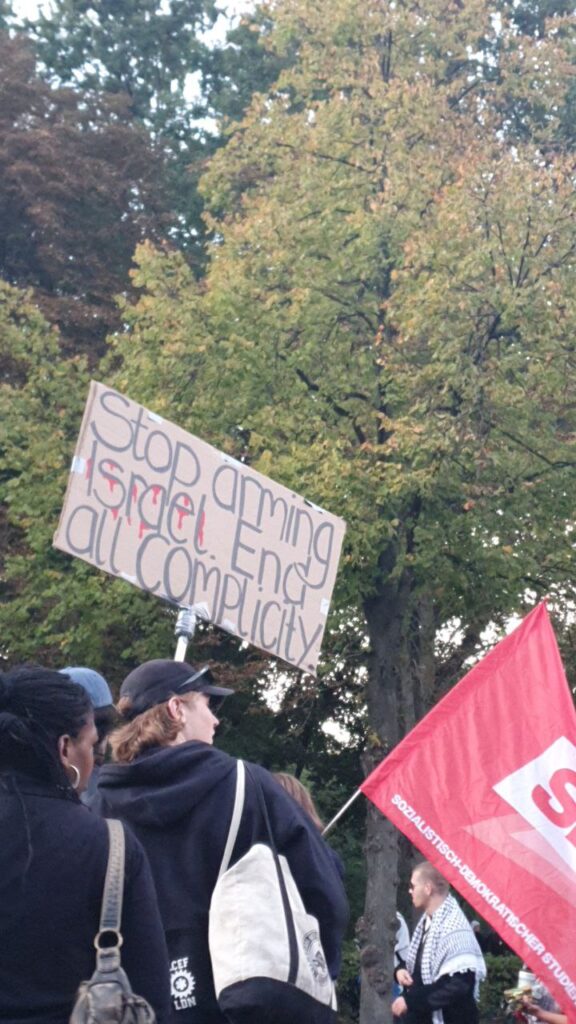
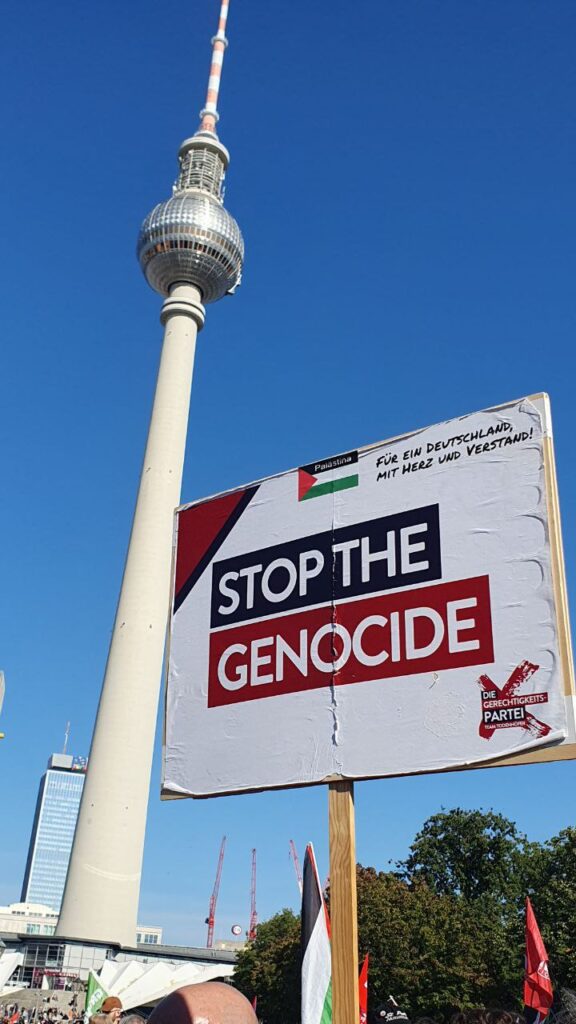
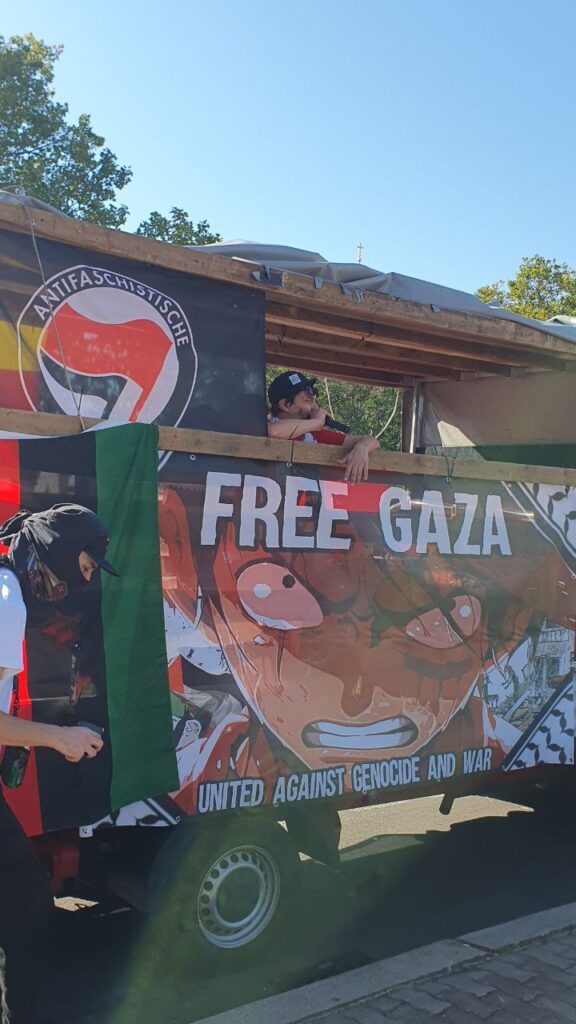
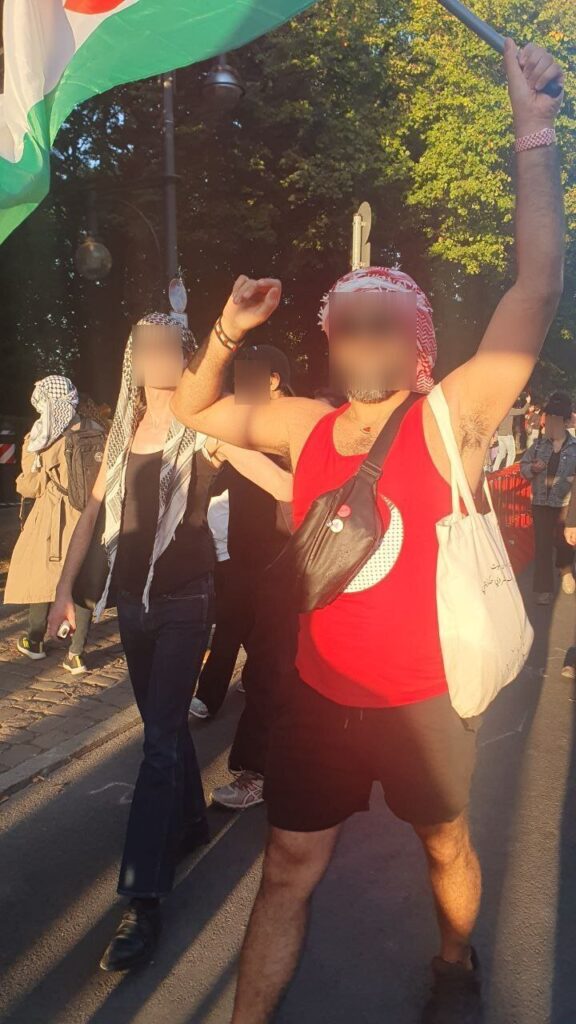
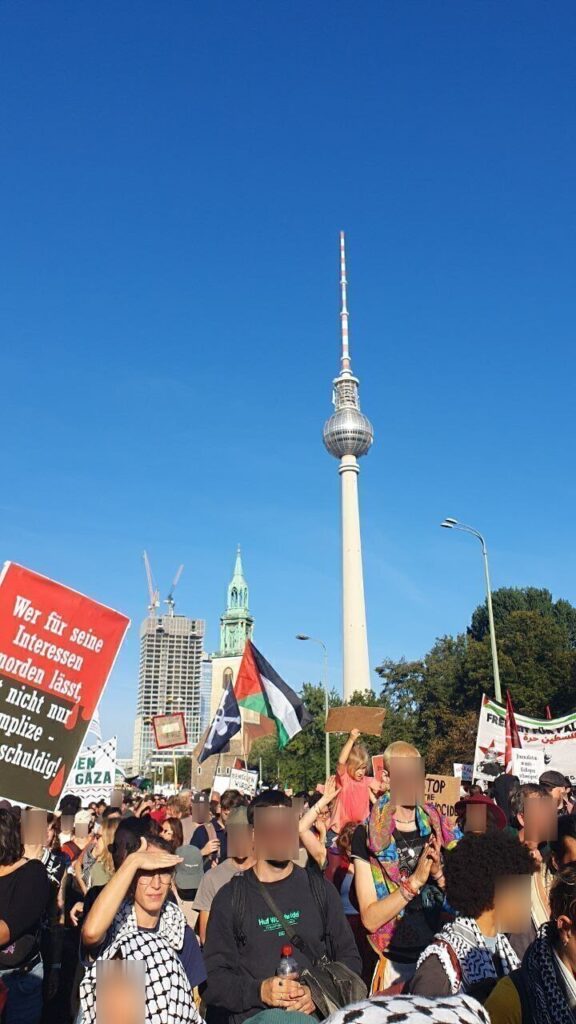
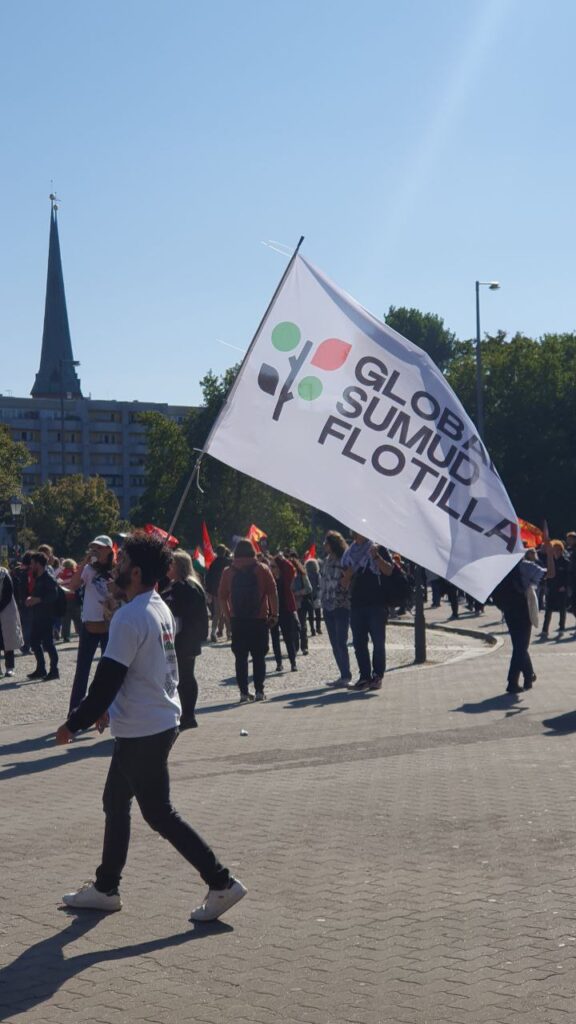
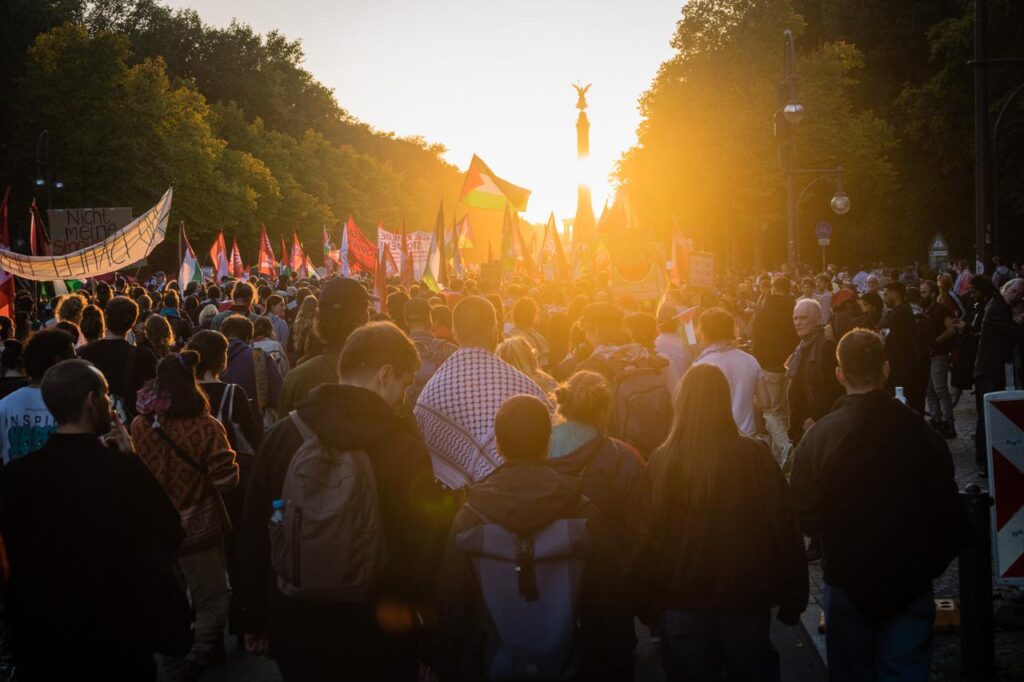
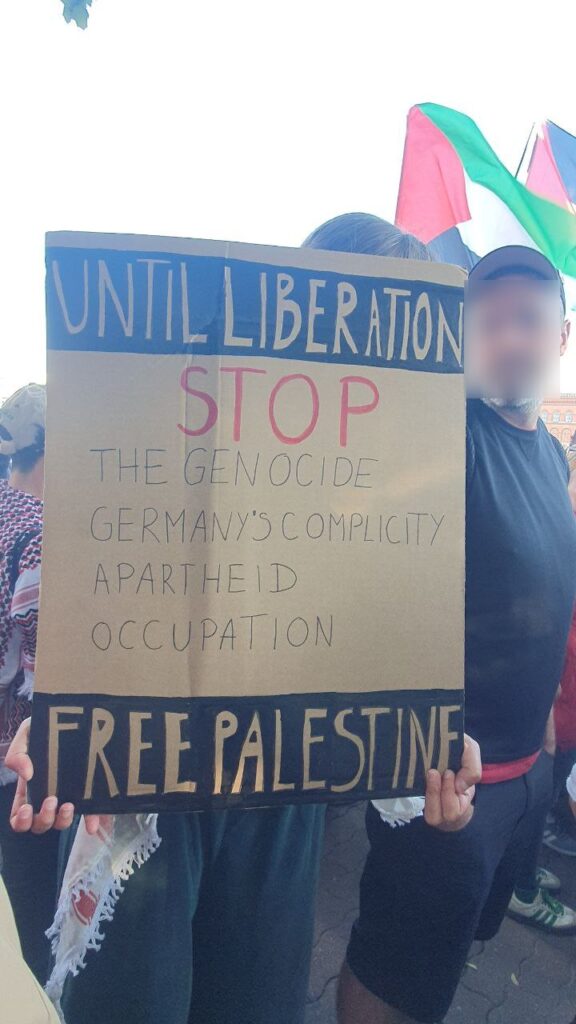
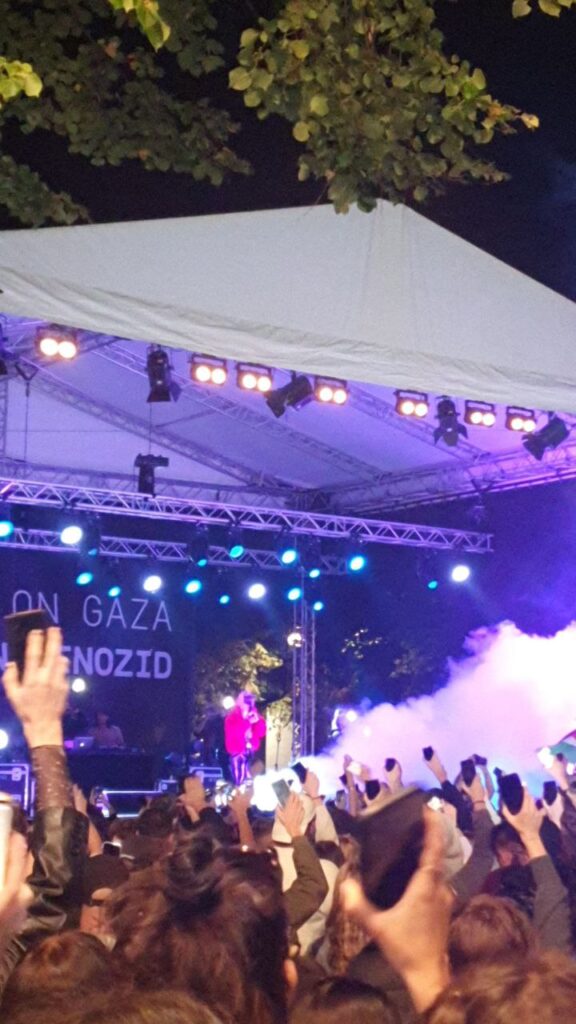
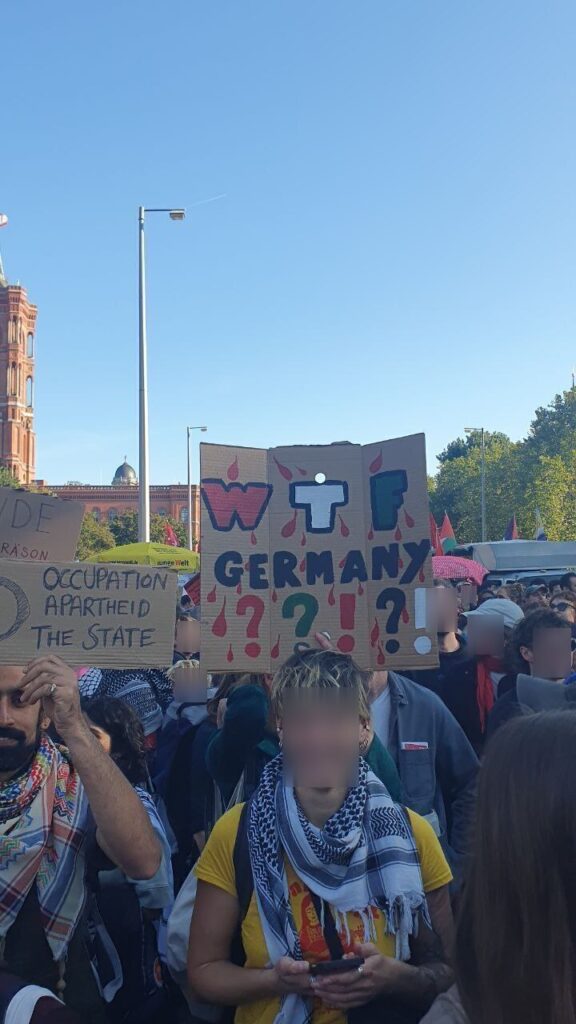
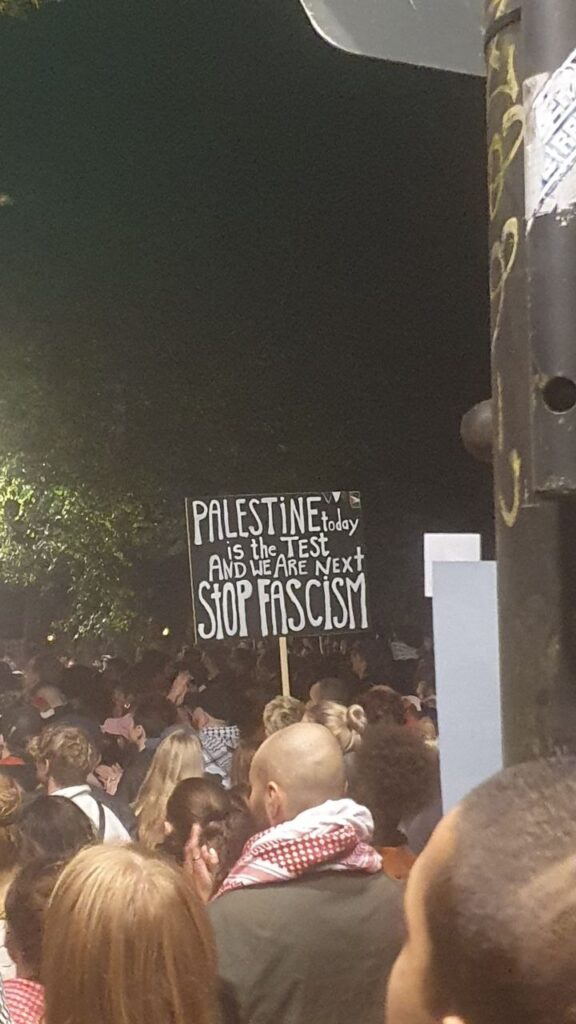
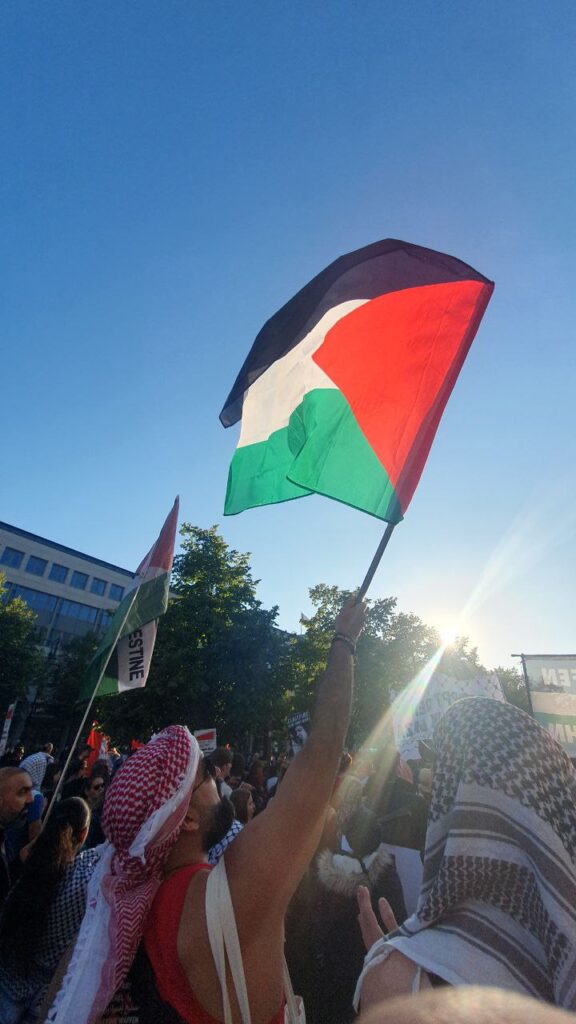
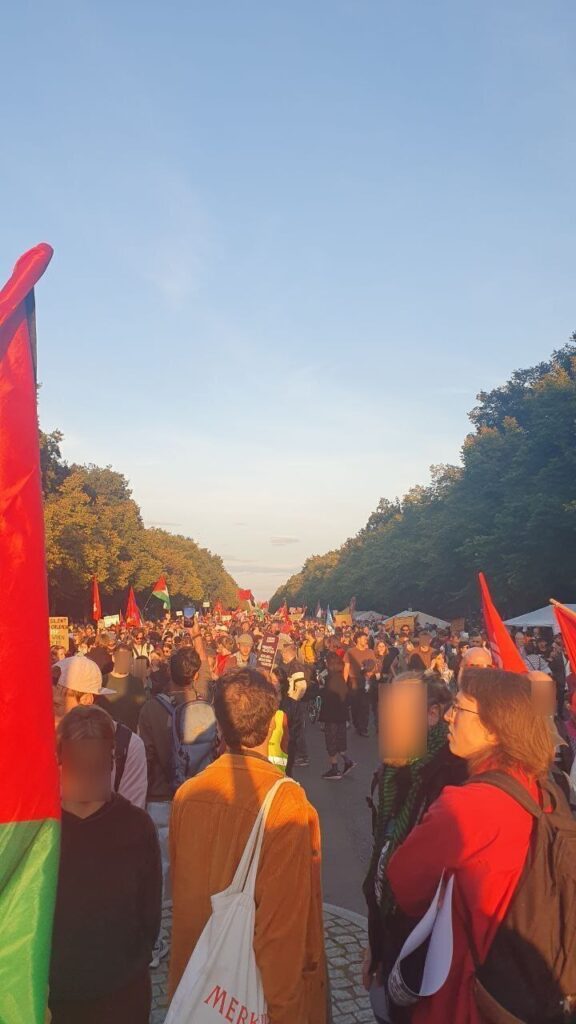
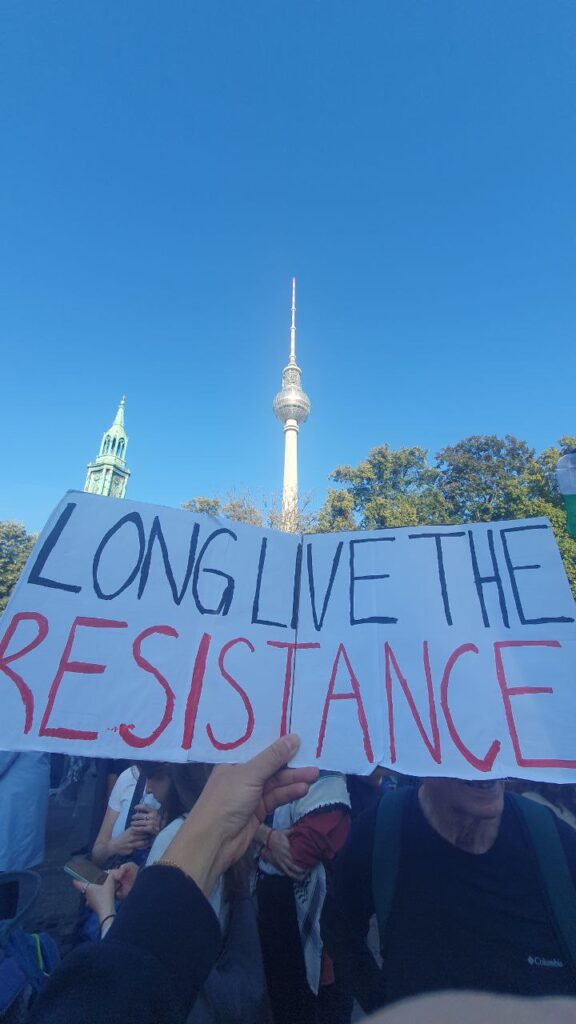
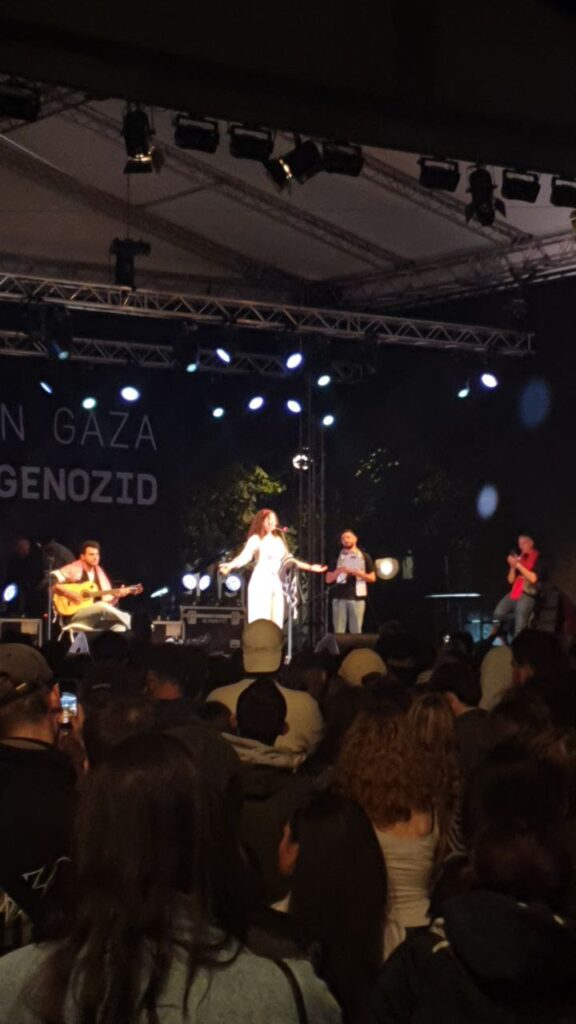
Photographs by: Compañera Emiliana, Jan Maas, Brian Janssen, and Ina Ko
Alexanderplatz to the Grosser Stern
The Left Berlin
30/09/2025
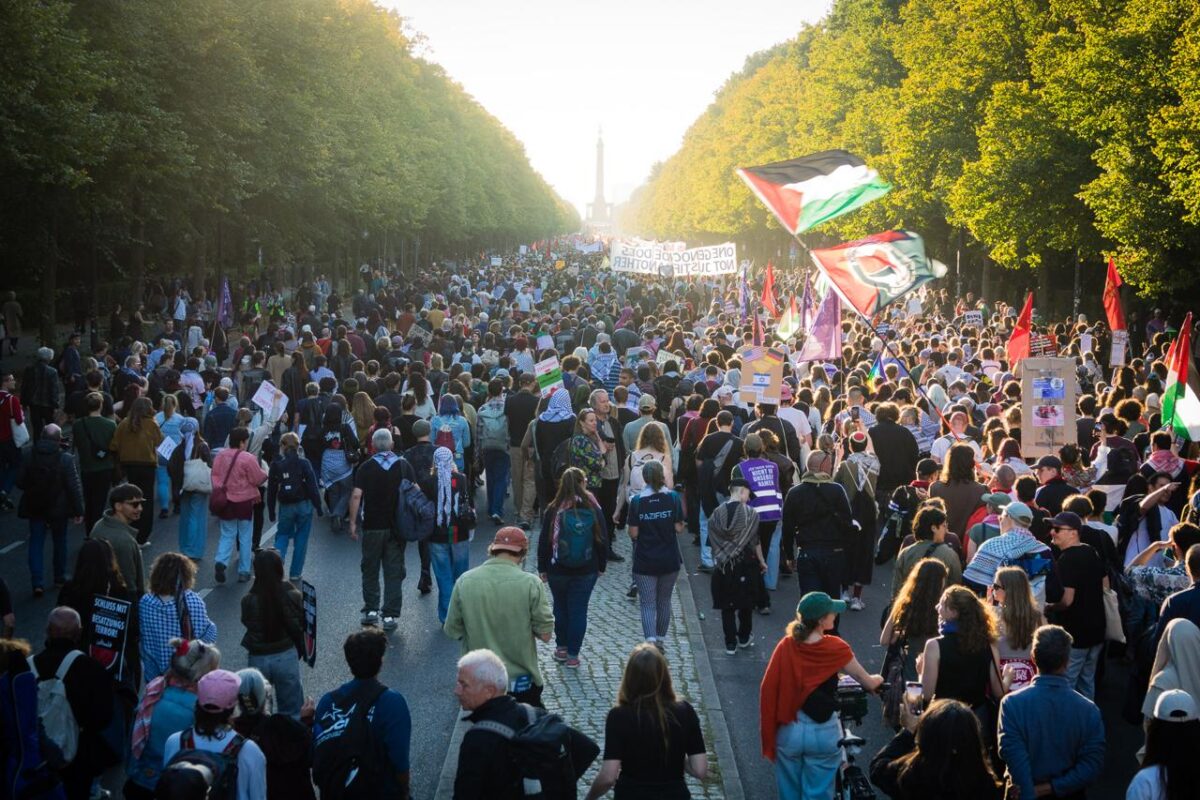
























































Photographs by: Compañera Emiliana, Jan Maas, Brian Janssen, and Ina Ko
Lawyers sue political leaders and CEOs amid ongoing state repression of solidarity
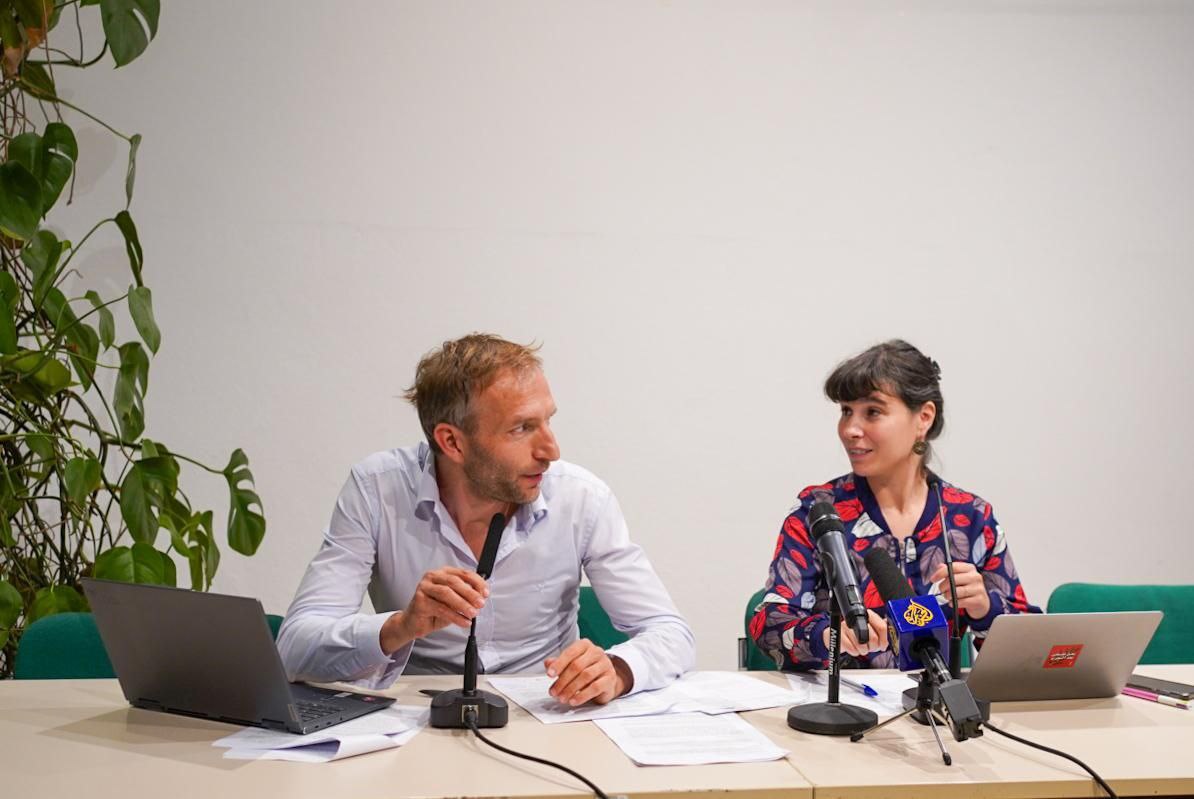
Note: This article was written prior to the demonstrations held in Berlin on 27 September.
A week before what are likely to be the largest demonstrations in German history in support of Palestine, a group of lawyers in Berlin are suing members of the current and previous governments, as well as CEOs of major arms companies, for complicity in the genocide in Gaza. On the day the lawsuit was announced, a group of activists observing trials against the pro-Palestinian movement released a devastating report on the state of justice in the city of Berlin.
On Friday, 19 September 2025, a group of lawyers from Berlin, with the support of the European Legal Support Centre (ELSC), the Palestine Institute for Public Diplomacy (PIPD) and Law for Palestine, filed a 100-page lawsuit against 11 political leaders and major German arms companies for their complicity in the genocide of the Palestinian people in Gaza.
The charges were filed at the State Attorney’s Office in Karlsruhe (Generalbundesanwaltschaft) against former and current members of the German government and CEOs of arms manufacturers, specifically former Federal Chancellor Olaf Scholz, former Federal Foreign Minister Annalena Baerbock, former Minister for Economic Affairs and Climate Protection Robert Habeck, current Federal Chancellor Friedrich Merz, current Federal Foreign Minister Johann Wadephul and Federal Minister for Economic Affairs and Energy Katherina Reiche, Federal Minister of Defence Boris Pistorius, as well as Dr Jörg Stratmann, CEO of Rolls-Royce Power Systems AG, Michael Humbek, CEO of Dynamit Nobel Defence GmbH, and Dr Alexander Sagel and Susanne Wiegand, current and former CEOs of RENK Group AG.
Germany is clearly a co-perpetrator of the genocide in Gaza, both in words and deeds. All the leaders sued by the group of lawyers have reiterated their complete sectarian devotion to the terrorist state of Israel and defended (almost) all its criminal actions. The German state has voted against or abstained from all votes in the UN or the EU to stop the massacre in Gaza and the occupation of the West Bank, and denies that Israel is committing apartheid. Germany is the only country in the world that, following South Africa’s genocide lawsuit before the International Court of Justice in The Hague, has presented itself as a co-defender of Israel.
Furthermore, as the lawyers explain in their lawsuit, Germany has increased its arms sales to the genocidal state of Israel tenfold since 7 October 2023, making it the second largest exporter of weapons to the Zionist state. Some of the large companies that have benefited from this increase in arms sales are those of the defendants mentioned above. War mercenaries are lining their pockets with money stained with Palestinian blood, with the approval of the German political leadership. This has led to a lawsuit filed by Nicaragua against Germany at the International Court of Justice in The Hague for its complicity in genocide.
Germany also continues to face three other lawsuits filed earlier by lawyers’ associations in the same country on behalf of people who have lost family members in Gaza, for its sale of arms to the genocidal state after the ICJ warned that Israel could be committing genocide in February 2024. A couple of these lawsuits have been dismissed on grounds that would make Kafka turn in his grave. The reasons given by the state’s legal team for dismissing the lawsuits are both Kafkaesque and stupid, such as the dates of arms export licences; you can’t stop what’s already been sent, but we can’t know when they’ll send more and we’re not going to ban it preventively, because the state’s legal team is unable to determine whether the weapons sent to Israel have been used to attack or defend in a textbook genocide.
Meanwhile, within its own territory, Germany criminalises all solidarity with Palestine. Demonstrations and events are being suppressed with increasing brutality. Freedom of assembly, expression and the press are being repressed by an authoritarian and racist state apparatus. This repression is overwhelming the courts with activists calling for an end to the genocide.
It is estimated that in Berlin alone, since 7 October 2023, 11,000 investigations have been opened against pro-Palestinian activists. Many of these investigations, under the mandate of the Berlin government, are going to trial. Hundreds of activists are facing trials for their participation in demonstrations, occupations and their activity on social media. That is why, in April 2024, a group of activists who had been witnessing and documenting racist trials against racialised people and political activists for 10 years split up and created a subgroup that attends trials against solidarity with Palestine.
This group of trial observers shows solidarity with people criminalised by the German government for their political activity against the terrorist state of Israel. Sometimes these same people are accused of spreading terrorist propaganda for shouting or posting on social media, ‘From the river to the sea, Palestine will be free’, a slogan that the German government, without evidence, attributes to Hamas. The group of observers also attends the trials to document them, as no public transcripts of what is said in them are kept.
Having attended more than 200 of these trials, these activists have presented a damning report with their conclusions on what they have seen in these proceedings. Among their conclusions are that the German judicial system acts as another arm of German state repression and is carrying out genuine lawfare against political activists. In fact, compared to other highly repressed political movements, such as those on the ‘radical’ left, those fighting for the rights of the Kurdish people, or climate activism, simply based on the numbers of trials held and planned, the authors conclude that the pro-Palestinian movement is the most persecuted in Germany since its reunification. They also conclude that there are clear racist biases in the state’s legal system and among many judges. Racialised people are often forced to attend courses on adapting to German society in addition to their sentence. Trials are largely held in high-security courtrooms, which re-criminalises a person whose only charge may have been trespassing on private property for staging a sit-in at their own university.
The observers themselves face difficulties in their work, with security personnel making them leave all their belongings in lockers outside and not allowing them to bring paper, pens and water into trials that can last up to five hours. For more information, the report translated into several languages can be found here.
This lawfare paid for by citizens, together with the repression of freedom of expression and assembly in the streets and censorship on social media, represents a clear and dangerous setback for democratic freedoms in Germany. A new large demonstration is expected on Saturday, 27 September, also in Berlin, and inshallah the streets will be filled with Palestinian flags and condemnations of genocidal Israel and its accomplice Germany.
How digital technology ensures the continuation of capitalist hegemony
Rezgar Akrawi
28/09/2025

During the recent assault on Gaza, thousands of activists were shocked to find their posts deleted or their accounts restricted simply because they documented the crimes of the Israeli occupation. Many felt powerless and angry, as if their voices were being deliberately silenced. This was not a coincidence or a technical glitch, but a vivid example of what can today be called “soft digital repression.” It is a form of repression that does not necessarily appear as direct bans or visible arrests. Instead it seeps in through invisible algorithms and all-encompassing digital technologies, to reshape the digital sphere to continue capitalist hegemony. This raises the question: how does this system work, and how can it be challenged?
Soft digital repression is a system of policies and technical tools that restrict freedom of expression and control the digital sphere by major corporations and powerful states. But in ways that appear neutral and non-confrontational. Instead of open censorship, explicit prohibition, or obvious repressive measures, it relies on gradual concealment techniques. It creates an environment in which individuals are subject to hidden surveillance—and sometimes even censor themselves.
The term “artificial intelligence” is often used in this context. Yet many practices—such as filter bubbles or the downranking of content—are not necessarily AI in the narrow sense. They are a part of a broader system of digital technologies and algorithms harnessed to serve capital.
How Hidden Censorship Operates: Digital Control and Voluntary Self-Surveillance
Imagine that everything you do in your digital life is monitored: your movements through your phone, private meetings, even your personal messages. This is not science fiction. Major tech corporations, cooperate with dominant states now. They systematically collect such data to categorize users according to their behavioral patterns and political or ideological leanings. Platforms are central tools for monitoring tendencies and containing them—whether through disinformation campaigns or by shrinking reach and influence.
It does not stop there. Thanks to carefully designed algorithms, access to leftist and progressive political content is restricted without being deleted. It appears as though only a weak interaction results from audience disinterest. In fact it is the intentional outcome of reduced visibility. Many have felt this: you write a post, and it reaches no one. Numerous studies have addressed the “filter bubble,” which isolates individuals from alternative content. For example, Facebook leaks, revealed the company deliberately reduced the reach of certain political or rights-based movements, while claiming neutrality.
Over time, many practice what can be called “voluntary self-surveillance”. This is self-censoring out of fear of bans, account closures, or declining reach. This fear changes the very nature of discourse, turning the digital sphere into a pre-shaped space that serves capitalist interests.
Digital Frustration
But repression is not limited to restricting content. There is another weapon, less visible and more effective: digital frustration. Through a constant stream of curated content, algorithms foster a general sense of helplessness and resignation,especially among leftist and progressive communities. Suddenly you are surrounded by messages that socialist experiments have failed and that resistance is futile. Meanwhile, capitalism is highlighted as an eternal force that cannot be defeated.
At the same time, individualism and personal success solutions—from self-improvement to consumption—are promoted as “realistic” alternatives to collective political action. In this way, people are isolated from one another and transformed into consumers rather than activists. This is not an accidental choice, but a deliberate class strategy to undermine the possibility of radical socialist change.
Digital Arrests and Digital Assassination
When censorship or frustration proves insufficient, the system escalates to a more dangerous level: digital arrests. eople suddenly find their accounts suspended for long periods, shadow-banned, or permanently shut down without warning. This is usually justified under pretexts like “violating community standards” or “promoting violence.” Censored content may only have documented capitalist crimes or human rights violations.
In many cases, repression reaches what can be described as “digital assassination”. That is the complete erasure of the digital presence of individuals or organizations. Labor movements, leftist organizations, independent media outlets, and human rights groups have seen their websites closed, archives deleted, or accounts disabled. The most striking example is the targeting of Palestinian content. Hundreds of accounts and posts documenting occupation crimes were deleted, while hate speech and Israeli right-wing propaganda were allowed to continue. This h shifts the digital sphere from a space of free expression to a meticulously monitored arena. One where capital decides what may surface and what must be buried.
What Can Be Done? Leftist and Progressive Alternatives
In the face of this, if soft digital repression seeks to suffocate resistance, the alternative must be to redefine technology itself as a tool of liberation. This can only happen through progressive leftist initiatives that push for transparency, democratic oversight, and strict laws. These laws should criminalize political surveillance and ban the use of algorithms and digital technologies to curtail freedoms.
But it is not only a matter of legislation. We need to also build cross-border solidarity networks to expose violations and put pressure on capitalist corporations. Non-expert users can take part by boycotting companies that sell surveillance technologies to authoritarian regimes, and placing them on blacklists. Instead open-source software and systems managed by independent bodies should be supported. They should include civil society representatives with collective oversight, and aim to expose violations and monitor governments, not to surveil citizens.
It is equally important for leftist organizations to develop their own tools. These should range from encryption technologies and privacy protection to awareness campaigns. They must reveal the hidden workings of algorithms. The struggle here is not merely technical, but is inherently political. Confronting digital capitalism is part of the class struggle itself. It continues the battles once fought only in factories, farms, and offices, and now extend to the digital sphere.
The example of digital repression against Palestinian content in particular, illustrates the scale of the problem. he most important lesson is that we must develop alternatives which are possible. Transforming digital technology into a tool of liberation, and linking it to a progressive leftist political project, can open new spaces for resistance. The internet was not created to be only a consumer marketplace, it can also be a site of collective internationalist struggle. But this will only be realized if we connect the digital battle to the wider struggle against capitalism and its class hegemony, and restore humanity to the center of digital decision-making.
Further Reading
Response to ‘Red Flag: No, East Germany wasn’t socialist—and neither is “democratic socialism”’
Internationale Forschungsstelle DDR
27/09/2025
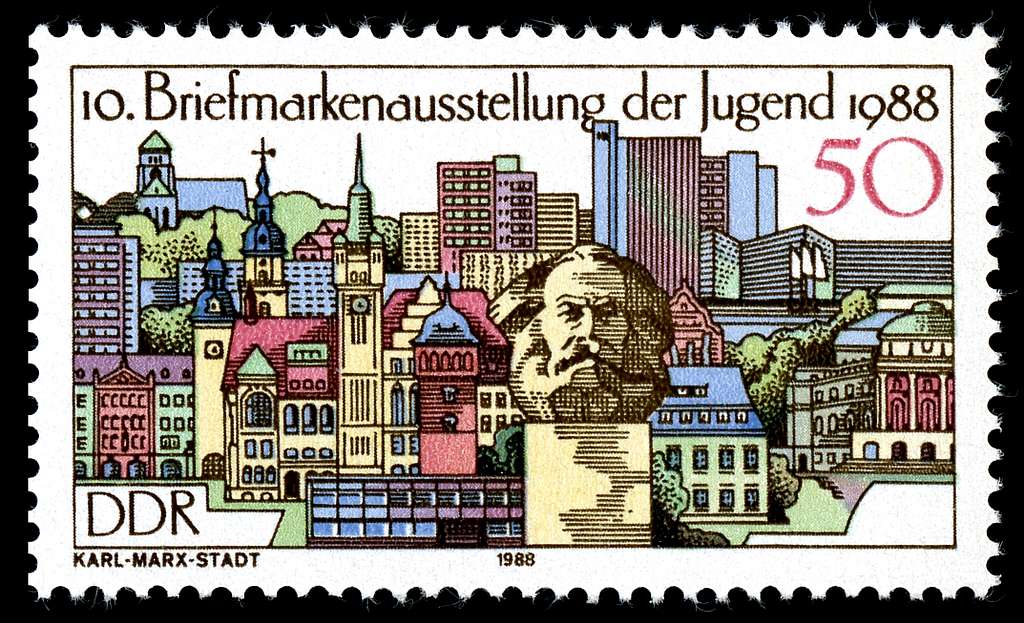
In early September, Die Linke leader Heidi Reichinnek made headlines after claiming her party’s vision of “democratic socialism” had nothing to do with the German Democratic Republic (GDR): “What we had in the GDR wasn’t socialism. At least not the kind my party envisions.” Germany’s conservatives soon jumped in to disagree: “The GDR was pure socialism. It was an unjust state.” Rather than counter this narrative, Nathaniel Flakin recently wrote an article which—though critical of her party’s programme of “democratic socialism”—agrees with Reichinnek’s assessment of the GDR. According to Flakin, “a society can only be described as socialist if it meets Marx’s criteria of evolving towards the abolition of classes and the state” and the GDR “did anything but wither [away].”
Underlying both Reichinnek’s and Flakin’s arguments are the anti-GDR talking points that have long been propagated in the Federal Republic of Germany (formerly “West Germany”). The GDR is said to have been thoroughly undemocratic or, as Flakin puts it, a “Stalinist state” ruled by a “privileged bureaucracy, obsessed with control.” The lack of democracy and “suppression of all criticism” was not only “an insult to human dignity”, it also “produced constant inefficiencies” and prevented “good planning.” The GDR is presented as a caricature of bumbling, self-enriching bureaucrats who could only uphold their ailing system through mass surveillance. Rather than being a point of reference that progressives can learn from, the GDR should be written off as nothing more than a “footnote of history” (Stefan Heym). Reichinnek and Flakin assure us that their versions of socialism will be different.
Such arguments against the GDR follow a similar pattern. First, a real and concrete problem in the GDR is identified. It is then taken out of its historical context and greatly exaggerated, before being generalized as a core, indefinite characteristic of the “Stalinist state.” Historical developments are distorted and decontextualized to create the impression that the GDR was broken and chronically ailing society. Flakin does exactly this when describing the East German economy. It is indeed true that the GDR faced significant challenges such as raising labour productivity or finding an adequate mechanism for price setting in the planned economy. However, blanket statements about “constant inefficiencies” are simply inaccurate and misleading.
The GDR economy proved itself to be robust and efficient over its 40-year existence. From 1949 until 1989, not a single year of stagnation or recession was recorded. In fact, in a paper published by Professor Gerhard Heske in 2009, East Germany’s annual growth rate (4.5%) is shown to have exceeded West Germany’s (4.3%) during the era of socialist planning (1951 to 1989). Data on the production and consumption of consumer goods confirms that the GDR was able to achieve the official objective of “meeting the growing material and cultural needs of the population” and thus progressively improving living standards.
Detractors of the GDR invariably ignore the context in which this socialist state operated. Since Germany’s heavy industries had historically been concentrated in the western regions of the country and due to the heavy damage inflicted on eastern Germany during the end phase of the Second World War, the GDR was compelled to construct large-scale industries from scratch in the late 1940s. The means of investment for this endeavour had to be accumulated internally, for East Germany possessed neither overseas colonies nor foreign benefactors (in contrast to West Germany, which received massive capital inflows through the Marshall Plan). The GDR alone had to rectify the damage inflicted by Hitler’s war after the Western powers violated the Potsdam Agreement and suspended reparation payments to the Soviet Union in 1946. Western sanctions also meant that trade with the resource-rich Ruhr Area in the West was no longer possible. All in all, seventy percent of East Germany’s pre-war industrial capacity was no longer available after 1945, which meant that living standards and productivity in the East were only nearly half of what they were in the West.
Through the resolute effort of millions of workers and through the efficient socialist planning system, the GDR was able to increase the volume of investment more than three-fold during the decade of socialist construction in the 1950s. By 1989, industrial production had increased by a factor of 12.3, and the gross domestic product had quintupled. These achievements were made possible by socialist property relations and the scientifically grounded planning process: far from being syphoned off and consumed by an exploitative “privileged bureaucracy,” the GDR’s surplus product was accumulated in the public hand and consciously reinvested to accelerate industrialization and economic development. The intricate planning system was structured around the Leninist principle of democratic centralism: economists and planning specialists collected data and analysed international and technological developments to draft perspective plans for the GDR’s economy. Workers and mass organizations then collectively discussed and amended these plans at the factory and neighbourhood levels. These plans thus combined complex expertise with democratic legitimacy.
Flakin withholds the title of socialism from the GDR because it failed to fulfil Leon Trotsky’s pronouncement that “socialism must increase human productivity, or it has no historical justification.” Here again, Flakin not only ignores the disadvantageous starting conditions in East Germany, but he also distorts reality. The GDR was in fact able to achieve a permanent increase in labour productivity throughout its existence. Even during the 1970s, when foreign trade was greatly affected by global energy crises and the GDR struggled to balance domestic accumulation and consumption rates, labour productivity continued to rise, albeit at slower rates than in previous decades. Many factors contributed to this trend, including the serious shortage of workers (meaning that existing production capacities could not be maximally utilised) and the political decision to prioritize consumer goods over industrial investments after 1971. These factors did not, however, alter the socialist nature of the GDR. It would be prudent to learn from the challenges that previous socialist states faced rather than brush them aside with the claim that “next time will be different.”
It is important to emphasize that the aforementioned economic problems did not lead to the “collapse” of GDR. Despite unsettled questions around pricing policies, labour productivity, and accumulation rates, the GDR was able to meet its domestic and international obligations and pay all wages until its final days of existence. The infamous accusations of bankruptcy are part of the narrative that seeks to discredit socialist planned economies: in 1989, East Germany’s debt-to-GDP ratio (roughly 19 percent) was less than half of West Germany’s (42 percent). In truth, the GDR was able to fundamentally change the face of the formerly underdeveloped agricultural region of East Germany and—in the span of just 40 years—propel the country into the ranks of the top fifteen industrialised states in the world.
Flakin and Reichinnek may disagree on Die Linke’s vision of “democratic socialism”, but they do agree on one thing: the GDR was certainly not democratic. This conclusion is easy to reach if one measures the GDR by the standards of bourgeois constitutionality: the separation of powers, the protection of private property, and equality before the law. Marxists have long argued that these principles were created by and for the capitalist class. Private property necessarily curtails democracy and limits popular rule over significant sectors of society. In a society divided into poor and rich, de jure equality can only lead to de facto inequality. Recognizing this reality, communists and social democrats in East Germany never sought to establish the GDR as a bourgeois constitutional state. They aimed to construct a fundamentally different type of democracy in which public ownership over the means of production would be enshrined in law and developed further by the people. The planning system was a core element of this idea: planning was understood as a social relation in which the people were to become increasingly active and conscious of their role as co-creators of society. Democracy was thus conceived of as a process, a continuous task to be deepened throughout the course of socialism.
The foundation for the GDR’s socialist democracy was laid during the so-called “anti-fascist upheaval” of the late 1940s. The East German economy was radically democratized through a land reform that redistributed the aristocrats’ lands to the peasants and the expropriation of industrial monopolists, which led to the creation of Volkseigene Betriebe (“companies owned by the people”). Economic power was thereby devolved to the working masses. Far from being bureaucratic policies from above, these measures were carried out by the people themselves. The Soviet military administration made a point to entrust the German people with the task of identifying and investigating which companies and estates should be marked for expropriation. Tens of thousands of workers and peasants joined so-called Sequester Commissions and Land Reform Commissions to collectively scrutinize their employers’ participation in Hitler’s Third Reich. Suddenly, workers and landless farmers found themselves entitled to investigate secret business records and uncover the connection between capitalism and fascism. In West Germany, on the other hand, popular efforts to socialize industries and banks were quashed by the authorities, despite democratic referenda on the issue. The “anti-fascist upheaval” of the late 1940s and “socialist construction” of the 1950s were profoundly democratic in both content and form. The claim that such major social feats were achieved through oppression and coercion is nonsensical.
Flakin claims that the GDR “suppressed all criticism.” In countless interviews with former GDR citizens, we heard otherwise. The factory and neighbourhood committees were in fact places of heated and controversial debate. Whereas in capitalism, democracy stops as soon as you enter the workplace, democracy in the GDR began behind the door of the factory or office. As a “workers’ and peasants’ state”, the GDR guaranteed employees the right to participate in factory management as well as a long list of social rights such as health and childcare, company holiday resorts, and further education. Many of these rights were laid out in the Labour Law, which was passed in 1961 after some 7 million citizens discussed and suggested over 23,000 amendments to the original draft. These laws authorized the workers themselves to monitor company directors and ensure adherence to health protections and workplace democracy. Company directors did not own the factories and could not enrich themselves off the backs of the workers; they were de facto employees of the state and merely charged with the supervision of public property. Workers who felt mistreated could complain through their union or the popular Eingabensystem (“system of appeal”), which guaranteed citizens the right to a response within four weeks. The extension of democracy into the economy also impacted the countryside, where the creation of cooperative structures helped to not only democratize decision-making processes, but also offered farmers and peasants the previously unknown benefits of paid holidays, childcare, and cultural activities.
In the GDR, all areas of society were to be democratized by drawing the masses into everyday governing. Citizens had the right—and the means—to participate in decisions not only regarding the workplace, but also the education of children, the distribution of housing, the development of the neighbourhood, and legal mediation. A pioneering aspect of socialist democracy was the mass organisations, including the Free German Trade Union Federation, the Peasants Mutual Aid Association, the Democratic Women’s League of Germany, the Cultural Association of the GDR, and the Free German Youth. These organisations were connected and interwoven with all areas of society to ensure representation for different groups. The Women’s League, for example, was guaranteed representation in residential committees, schools, cultural centers, and parliament, where it helped advance women’s economic emancipation from men. In contrast to the unions and organizations in capitalist societies, the GDR’s mass organizations were not fragmented and treated as private lobby groups; they were political organizations empowered by the state to encourage the collective deliberation and implementation of socialist policies.
The judiciary, which in capitalist societies is typically far-removed from popular will, was also democratized in the GDR. So-called societal courts were set up in workplaces and residential areas to address conflicts and problems in direct and relatable ways. Members of the courts consisted of one’s peers, for they were elected by the people directly. Workers, teachers, scientists, craftsmen, and artists were all practicing law to help settle issues. Through the courts, the mass organizations, and the Eingabensystem, GDR citizens had many ways to bring about concrete changes in their everyday lives.
Recognizing these institutions as innovations of socialist democracy in no way precludes critical appraisal. It is clear when assessing GDR history that while certain periods were marked by rapid advances, others were characterized by stagnation. The latter phases should be analyzed in their historical context if we are to learn anything from them. It cannot be forgotten that the GDR was located on the frontline of the “Cold War,” with West German leaders openly declaring the intention “to do everything and to take every measure to retake [East Germany].” Nevertheless, socialist democracy is an evolving process in which citizens must increasingly recognize and use the means of production and the instruments of democracy as their own. This requires the consistent use and further development of established institutions. In the GDR, there are clear signs that this process slowed down towards the 1980s. But, again, such developments did not change the socialist character of the GDR. Rather, they point us to a problem that all post-capitalist states have faced in the past: how can revolutionary momentum be maintained in the long run to ensure that social relations continue to evolve? It is especially difficult when this necessity to open up institutions and broaden democracy comes into tension with the need to defend against counterrevolution and external threats. The GDR was by no means the only socialist state to face this challenge of balancing democracy with security, and it would be naïve to believe that future attempts to construct socialism will be free of it. As Lenin wrote in 1920: “The proletariat’s conquest of political power does not put a stop to its class struggle against the bourgeoisie; on the contrary, it renders that struggle most widespread, intense, and ruthless.” Praxis—not abstract speculation—is the criterion of truth. The idea that the state will immediately begin withering away under “true socialism” is a regression to the utopianism Marx and Engels criticized so sharply in their time. Instead of kow-towing to the ruling narrative and disowning the GDR, we must uphold it as Germany’s first socialist state. The collective efforts of millions of GDR citizens have given us four decades of praxis to learn from. By reclaiming this history as our own and investigating it on our own terms, we can gain a deeper perspective on the fundamental possibilities and difficulties that arise when constructing social, economic, and political models beyond capitalism.
A durational (street) performance in Serbia based on Timothy Snyder’s book
Ivana Jecmenica
26/09/2025
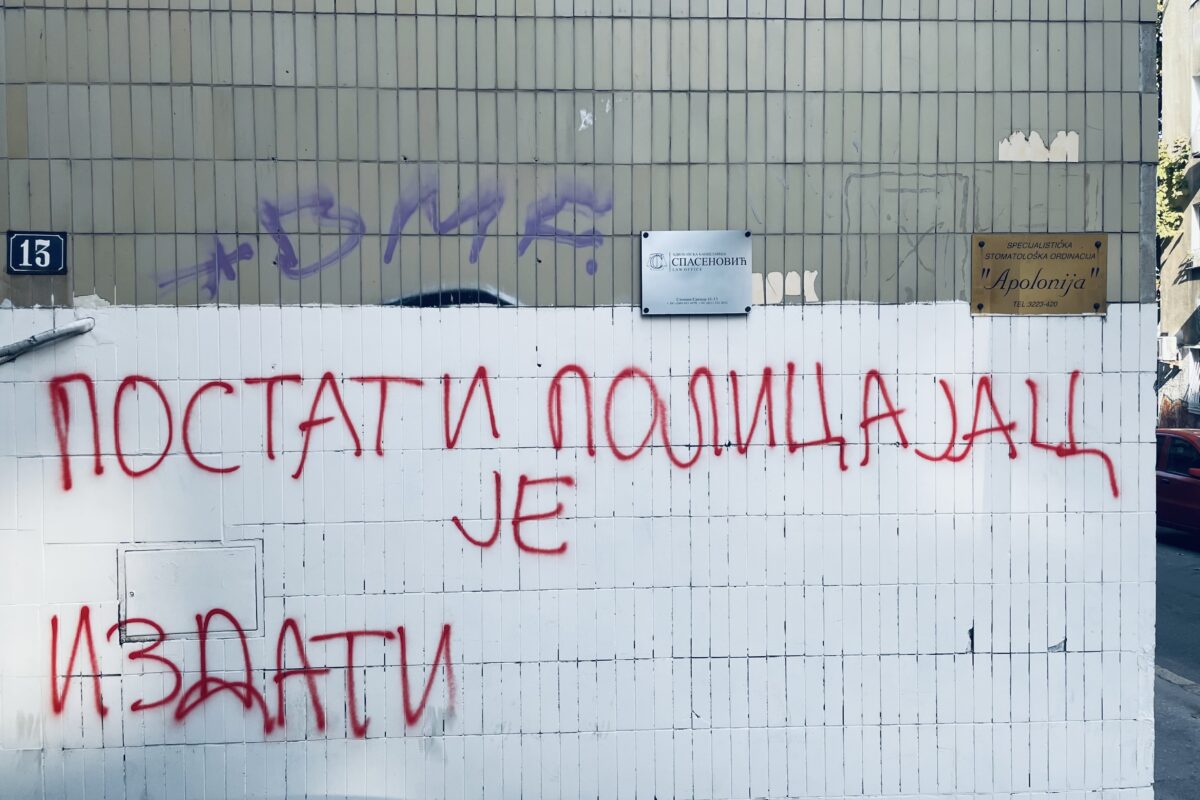
It seems we consume everything and everyone today, including ourselves. We have lost a clear sense of what freedom is. If we do not trade our labour for it, it is unattainable. Much like democracy: without an abundant budget, it collapses. Paradoxically, fascism often begins for free. In such circumstances, tyrants are always cast as the saviours of the nation in the first act. Once we transition to the next act, we can no longer distinguish reality from myth and fabricated truths, as if the storage of centuries of knowledge had been erased and the operating system of each of us reset, leaving us to absorb whatever is served at the moment. We are losing our grasp inhabiting a liminal space—not one of ritual, but an unexpiring period of semi-blindness and semi-life.
In this light, a book like this must remain within daily reach—as a reminder of an anti-tyrannical lifestyle in times when tyrants hold global power, peoples are oppressed as if genocide were not occurring, and the world persists in silence, preoccupied with consumerism instead of demanding demanding the termination of brutalities and accountability. We are, after all, intelligent beings and human enough (although Franco Bifo Berardi noted at Miss Read Art Book Fair in Berlin that humanity has become ridiculed) to envision a wiser future, informed by historical and contemporary research, refusing to allow anyone to monopolise our ethical reason and empathetic heart.
Snyder approaches tyranny ontologically, recalling times when women and animals were regarded as equivalent, and tracing its evolution through slavery, colonialism, and imperialism. According to him, European history has witnessed three major democratic moments: following the First World War in 1918, after the Second World War in 1945, and after the end of Communism in 1989. Meanwhile, economics and global trade have fostered mass politics, while idealised, quasi-divine leaders have collapsed democracies into right-wing authoritarianism and fascism—rejecting reason in the name of “reason” and turning back to mythomania and messianic promises of salvation from the Other, usually evil and external. Somewhat simplistically, Snyder equates fascism and communism, a tendency I regard as problematic within mainstream liberal philosophy, though I will not dwell on this further.
The book encourages us to apply the knowledge acquired in the twentieth century, offering twenty lessons for resisting contemporary threats to democracy. Notably, Snyder references Orwell, Arendt, and Kiš within a shared anti-totalitarian context, reminding us of these thinkers in case we have forgotten—or never encountered them, as may be true for Danilo Kiš from Yugoslavia/Serbia. Kiš was persecuted as an intellectual and labeled an enemy of the state, a fate that resonates today with the precarious position of universities and critical thought worldwide. A concrete example can be found in Serbia, where students and their professors have, for ten months, resisted with educated courage and principled disobedience. They accepted the consequences and refused to sit passively in a waiting room for justice and “anti-fascist living”. No other approach would work with tyrants, especially within neoliberal systems that undermine solidarity and leave no one safe, often through the selective application of law. When states and international institutions fail to protect us, we must exercise self-protection. Serbian students, together with those who joined them, have successfully embodied Snyder’s twenty lessons. In the following text, I aim to substantiate this, quoting the introduction to each lesson.
1. DO NOT OBEY IN ADVANCE
“Most of the power of authoritarianism is freely given. In times like these, individuals think ahead about what a more repressive government will want, and then offer themselves without being asked. A citizen who adapts in this way is teaching power what it can do.” (p.17)
This behaviour begins locally and then spreads across the country like a self-managed network of obedience, becoming an unquestioned constant in the political system. Citizens believe such conduct preserves them and their families, but in reality, it only entrenches economic and socio-political slavery.
By contrast, Serbian students and their allies have inverted this “game”: they teach power what it can no longer do, compelling the repressive government to confront the very wishes and demands that students themselves imposed. In doing so, they expose the regime’s illegal and criminal deeds, signalling the necessity for each citizen to ask whether their own servile complicity places them in violation of the law.
2. DEFEND INSTITUTIONS
“It is institutions that help us to preserve decency. They need our help as well. Do not speak of “our institutions” unless you make them yours by acting on their behalf. Institutions do not protect themselves. They fall one after another unless each is defended from the beginning. So choose an institution you care about — a court, a newspaper, a law, a labor union — and take its side.” (p.22)
Serbia is a kidnapped state with institutions that are consequently compromised. Students have resolved to reclaim them, persistently reminding these bodies of their fundamental functions. It is an arduous struggle against a deeply entrenched system of corruption that encompasses the courts, the Prosecutor’s Office, the Regulatory Authority for Electronic Media (REM), the Republic Electoral Commission (RIK), and Radio Television of Serbia (RTS). In the process, students have also built connections with various labour unions. Yet much work remains before they can truly declare: the institutions are ours, and it is our responsibility to safeguard them henceforth.
3. BEWARE THE ONE-PARTY STATE
“The parties that remade states and suppressed rivals were not omnipotent from the start. They exploited a historic moment to make political life impossible for their opponents. So support the multi-party system and defend the rules of democratic elections. Vote in local and state elections while you can. Consider running for office.” (p.26)
This is precisely what has happened in Serbia, persisting now for thirteen years. The opposition has been dismantled, and politics has become a realm that decent citizens avoid. In response, students have initiated a repoliticisation of the public sphere, effectively proving the theory: the private is political. Given the stage of the Leviathan in Serbia—marked by its ignorance and defamation of opponents—students and their allies have demanded both republic and presidential elections, despite the clearly undemocratic conditions already confirmed by the European Union in December 2024.
Meanwhile, rebelling citizens have organised themselves and built grassroots connections across the country, many of whom are prepared to monitor and protect the very exercise of elections. The president, who once called elections at will with unshakeable confidence in his victory, now speaks only of the possibility of elections in 2027. At the same time, students are preparing their own political list of non-compromised representatives and experts. Since the opposition in Serbia is far too weak to run an election without serious reorganisation and strategic planning, many individuals who would never have considered entering the political arena are now more than ready to participate.
4. TAKE RESPONSIBILITY FOR THE FACE OF THE WORLD
“The symbols of today enable the reality of tomorrow. Notice the swastikas and the other signs of hate. Do not look away, and do not get used to them. Remove them yourself and set an example for others to do so.” (p.32)
Aware of the self-proclaimed Serbian Progressive Party State, students are risking everything for absolute democracy, giving their country a hand-made “facelift” by reclaiming its flag, anthem, and Republic Day. This achievement was reinforced by long, nationwide marches that united citizens in committed solidarity.
At the same time, the regime regularly labels students and their supporters as fascists, terrorists, Nazis, and the like—culminating in a large banner displayed in the center of Belgrade that read: “Better ćaci (a neologism for the regime’s proponents) than Nazi”, with the swastika visibly crossed out. Two women destroyed the banner, but they were arrested—not the mastermind who had used the prohibited symbol under Serbian law. Thinking and acting beyond the local, students also rode bicycles and ran a relay marathon to Strasbourg, i.e., Brussels, reminding the EU of its own democratic values.
5. REMEMBER PROFESSIONAL ETHICS
“When political leaders set a negative example, professional commitments to just practice become more important. It is hard to subvert a rule-of-law state without lawyers, or to hold show trials without judges. Authoritarians need obedient civil servants, and concentration camp directors seek businessmen interested in cheap labor.” (p.38)
Professionally ethical, students are doing their job: engaging in critical thinking, bridging past, present, and future, and prioritising futurabilities. When they encounter gaps in their competencies, they turn to professors and other professionals for assistance. There is no shame in not knowing—only in pretending to possess expertise in everything (cf. the Serbian president). Among the first supporters of the students was the Bar Association of Serbia. Together, they demonstrated to the public that the law is not inherently against them; rather, citizens’ indoctrinated ignorance and mistrust have led them to abandon reliance on it. In addition, lawyers and judges who serve state power are now being publicly denounced and will be held accountable as soon as the juridical system is restored and the executive is separated from the legislative branch.
Extrapolating to a more global level, European business interests are focused on Serbian lithium, while Serbian autocrats locally sell the narrative of immense economic prosperity, “beautifying” the harsh reality that this country is also a site of cheap labor extraction, as if we cannot consult independent scientists and corporate lawyers.
6. BE WARY OF PARAMILITARIES
“When the men with guns who have always claimed to be against the system start wearing uniforms and marching with torches and pictures of leaders, the end is nigh. When the pro-leader paramilitary and the official police and military intermingle, the end has come.” (p.42)
Although not paramilitaries in the strict sense, plainclothes police, state-organised hooligans, and loyalists function as informal instruments of state violence and intimidation. Since the police usually act not as neutral enforcers of the constitution and law but as servants of a single individual, this is blatant proof that democracy is absent in Serbia.
Fortunately, students and their supporters have recognised and mobilised their own disruptive agencies, successfully deconstructing the uniforms and accessories that have, for decades, been celebrated here—even allowing war criminals to be hailed as national heroes. They have read the police oath aloud in the streets, face-to-face with fully equipped officers, often masked with balaclavas. Such menace can be paralysing for civil disobedience, yet in this case it has clearly accelerated the regime’s self-destruction.
7. BE REFLECTIVE IF YOU MUST BE ARMED
“If you carry a weapon in public service, may God bless you and keep you. But know that evils of the past involved policemen and soldiers finding themselves, one day, doing irregular things. Be ready to say no!” (p.47)
This is an alarming reality. The forces of state control deploy unnecessary violence against unarmed and peaceful citizens—particularly students and high school pupils—who never initiate attacks but at most attempt self-protection, often linguistically. One such instance was an invitation to the police to march alongside the protesters in order to secure order and peace.
The students’ main weapons are their own bodies, hands raised, which the police regularly misuse as a pretext to beat them without reason. And yet, the students persist, reciting a poem by the late Serbian academic Ljubomir Simović (1985):
“I will rise,
crushed, shattered, oppressed,
at steel armies
with a wooden sword…”
This raises an urgent question: how long will the police forces continue to obey the orders of a regime acting against its own people, determined only to prolong its stay in power, while the EU turns a blind eye? Since protesters consistently remind the police of their legal obligations, they may soon begin quoting Snyder as well.
8. STAND OUT
“Someone has to. It is easy to follow along. It can feel strange to do or say something different. But without that unease, there is no freedom. Remember Rosa Parks. The moment you set an example, the spell of the status quo is broken, and others will follow.” (p.51)
Students are practicing this with the utmost determination. They have stood out and articulated a different reality, opening horizons of new possibilities for the country. Fully aware of the possible consequences, they have shown a readiness to confront tabloids and corrupt politicians intelligently, dismantling their lies, plagiarism, and other manipulations. Their actions have liberated many other citizens, both domestically and diasporically, and even inspired parallel struggles, such as in Georgia.
People are following, but this time with eyes wide open, as the movement encourages everyone to reflect and participate directly, contributing to a shared goal and embodying plurality through collaborative diversity.
9. BE KIND TO OUR LANGUAGE
“Avoid pronouncing the phrases everyone else does. Think up your own way of speaking, even if only to convey that thing you think everyone is saying. Make an effort to separate yourself from the internet. Read books.” (p.59)
Students first read the Blockade Cook. They generously introduced us to a new constitution-based mantra—“You’re not authorised!”—as a way of addressing the president. They emancipated all the dialects of Serbia in a gesture of linguistic solidarity that strengthened connection and trust across communities. They simply began calling things by their names—a subversive act in a country of multilayered propaganda. At once digital and analogue, they embody a practice of factual agitation.
10. BELIEVE IN TRUTH
“To abandon facts is to abandon freedom. If nothing is true, then no one can criticize power, because there is no basis upon which to do so. If nothing is true, then all is spectacle. The biggest wallet pays for the most blinding lights.” (p.65)
Students managed to “de-fake” news and dismantle the spread of alternative facts in the public sphere. They decoded the regime’s spectacle, often parodying it and debunking its lies in real time, in highly creative and sharp ways. This is surely one of the main reasons why so many citizens have joined their side—the side where truth resides.
11. INVESTIGATE
“Figure things out for yourself. Spend more time with long articles. Subsidize investigative journalism by subscribing to print media. Realize that some of what is on the internet is there to harm you. Learn about sites that investigate propaganda campaigns (some of which come from abroad). Take responsibility for what you communicate with others.” (p.72)
Students are the newest socio-political investigators. In light of the long-standing absence of genuine journalism in the main public sphere, they have competently assumed this role—consulting with experts and drawing on the support of their professors. Numerous NGOs engaged in investigative journalism, socio-political monitoring, and research also stand by their side. Their inquiries extend beyond politics to economics and ecology. While exposing the harms associated with the internet, they also employ it as an ally in a country where media freedom is under constant threat. They refrain from communicating until facts are verified, paying careful attention to timing and to language itself, which has already been blatantly polluted by the dominant actors of political discourse.
12. MAKE EYE CONTACT AND SMALL TALK
“This is not just polite. It is part of being a citizen and a responsible member of society. It is also a way to stay in touch with your surroundings, break down social barriers, and understand whom you should and should not trust. If we enter a culture of denunciation, you will want to know the psychological landscape of your daily life.” (p.81)
I would argue that this is an area in which the students possess exceptional skills, demonstrated through acts of countrywide intergenerational hugging and collective crying. They made people in remote parts of Serbia feel seen and relevant. By reintroducing fundamental human values, they reclaimed their significance for strengthening the social body. They reminded us that solidarity dismantles alienation and shifts fear onto the side of the oppressor, who will no longer so easily perpetuate cycles of corruption and intimidation. They also restored the diaspora’s sense of belonging to the home country. In doing so, students have definitively liberated citizens from psychological and moral self-oppression.
13. PRACTICE CORPOREAL POLITICS
“Power wants your body softening in your chair and your emotions dissipating on the screen. Get outside. Put your body in unfamiliar places with unfamiliar people. Make new friends and march with them.” (p.83)
We assumed that Generation Z was active only in the digital world, but we were wonderfully mistaken. Students have transformed Serbian public space into a parliament of body politics. They resist, demand, and disrupt. They have created a collective, disobedient body that—though vulnerable and heavily precarised in a non-democratic state—refuses invisibility and silence. In the longer run, this multiplies the occasions to be bold and daring.
14. ESTABLISH A PRIVATE LIFE
“Nastier rulers will use what they know about you to push you around. Scrub your computer of malware on a regular basis. Remember that email is skywriting. Consider using alternative forms of the internet, or simply using it less.
Have personal exchanges in person. For the same reason, resolve any legal trouble. Tyrants seek the hook on which to hang you. Try not to have hooks.” (p.87)
The students have never presented themselves as experts; they are still learning by doing, particularly after being illegally spied on and persecuted without any justification from the state. They actively share their knowledge, and in this way began disseminating information on how to keep certain matters private. Lawyers have provided significant assistance in this process. Citizens are gradually becoming educated about their own rights, developing familiarity with the law and the constitution after long experiencing them as instruments of disadvantage. Recognising the protective functions of the state apparatus, and learning to employ them effectively, certainly requires both engagement and careful reflection.
15. CONTRIBUTE TO GOOD CAUSES
“Be active in organizations, political or not, that express your own view of life. Pick a charity or two and set up autopay. Then you will have made a free choice that supports civil society and helps others to do good.” (p.92)
Over the past ten months, students have consistently directed their efforts toward socially beneficial causes. Organised in plenums, they actively engage in the management of everyday life, whether within their faculties, affiliated institutions, or public spaces across Serbia. In doing so, they set a compelling example for citizens, demonstrating the possibilities of participation and self-determination in both local and broader communities (e.g., citizens’ assemblies).
Their initiatives have included fundraising for colleagues’ medical treatments (a widespread necessity in Serbia, where SMS-based donations are often relied upon), organising charity fairs, and mobilising aid for those affected by recent wildfires across several regions. When individuals are persecuted by the state for their socio-political positions, the students do not abandon them; instead, they coordinate support both locally and within the diaspora, as exemplified by the case of a bus driver.
16. LEARN FROM PEERS IN OTHER COUNTRIES
“Keep up your friendships abroad, or make new friends in other countries. The present difficulties in the United States are an element of a larger trend. And no country is going to find a solution by itself. Make sure you and your family have passports.” (p.95)
Authentically friendly and open-minded, students delight in building new friendships. Some even cycled and ran a relay marathon across Europe to facilitate mutual exchange of knowledge and information. In the 21st century!? They can be a bit silly, too. Their connections extend to peers engaged in parallel struggles in Georgia, North Macedonia, Montenegro, Slovakia, Turkey, Hungary, and beyond. This is a generation that does not aspire to abandon the country, even though they are fully aware that the current regime plays dirty and unlawfully. They are therefore prepared to protect both themselves and others, recognising that this fight is a marathon, not a sprint.
At the same time, I would gladly see other countries—especially their students—learning from them: resisting state oppression against freedom of speech and the right to peaceful assembly, and reasoning beyond the so-called reason of the state itself.
17. LISTEN FOR DANGEROUS WORDS
“Be alert to the use of the words extremism and terrorism. Be alive to the fatal notions of emergency and exception. Be angry about the treacherous use of patriotic vocabulary.” (p.99)
As individuals who have undergone a state-induced transition—from “good, but manipulated kids” to “fascists and terrorists determined to dismantle the constitutional order”—students understand the intricate relationship between language and power, even before engaging with Foucault, Derrida, Althusser, and others. They have shown that what the president attempts to sell as ballot bait is nothing more than patrioticised nationalism, and in doing so, they have undertaken crucial conceptual redefinitions. Though deeply angered, they remain neither rude nor manipulative, nor do they step into the regime-nourished petit bourgeois garden.
18. BE CALM WHEN THE UNTHINKABLE ARRIVES
“Modern tyranny is terror management. When the terrorist attack comes, remember that authoritarians exploit such events in order to consolidate power. The sudden disaster that requires the end of checks and balances, the dissolution of opposition parties, the suspension of freedom of expression, the right to a fair trial, and so on, is the oldest trick in the Hitlerian book. Do not fall for it.” (p.103)
When the state practiced sonic terror, students remained calm and helped others compose themselves. When the state attributed its own acts of terror to disobedient citizens, it was immediately exposed, leading to yet another loss of authority for the regime. They categorically refuse to emulate Hitler’s students—though some pro-regime professors have willingly become just that. Instead, they have resolved to keep rising, bringing us along with them. They leave no one behind, not a single antifascist.
19. BE A PATRIOT
“Set a good example of what America means for the generations to come. They will need it.” (p.111)
Students love their country, and this time their brains are not draining abroad. It makes the tyrants panic. They are already planning for their future children and have made the diaspora feel welcome to return without regrets. To be a patriot, perhaps, also means living one’s mother tongue lively.
20. BE AS COURAGEOUS AS YOU CAN
“If none of us is prepared to die for freedom, then all of us will die under tyranny.” (p.115)
They are braver than they themselves could have imagined. They are preparing us for freedom. Now we all proclaim loudly: THERE’S NO GOING BACK! WE WILL WIN THIS! And the people of the Balkans carry mountains in their hearts. Have you ever seen anything more enduring than that geography?
As Stanley (2018) emphasised, fascism also operates through anti-intellectualism and the systematic attack on experts—a dynamic Serbian students directly confront by mobilising knowledge, critical thought, and solidarity. Yet Braidotti and Dolphijn (2023) remind us: “The crucial question however is: who and how many are ‘we,’ those who desire an anti-fascist life?” The students’ example provisionally answers that even under extreme repression, “we” can be created, expanded, and sustained through courageous, collective action—believing in a brighter future as scientists, rather than as religious or other fanatics.
Snyder’s political theory proves far more potent in practice.